Haiyore! Nyaruko-san W Episode 5 References
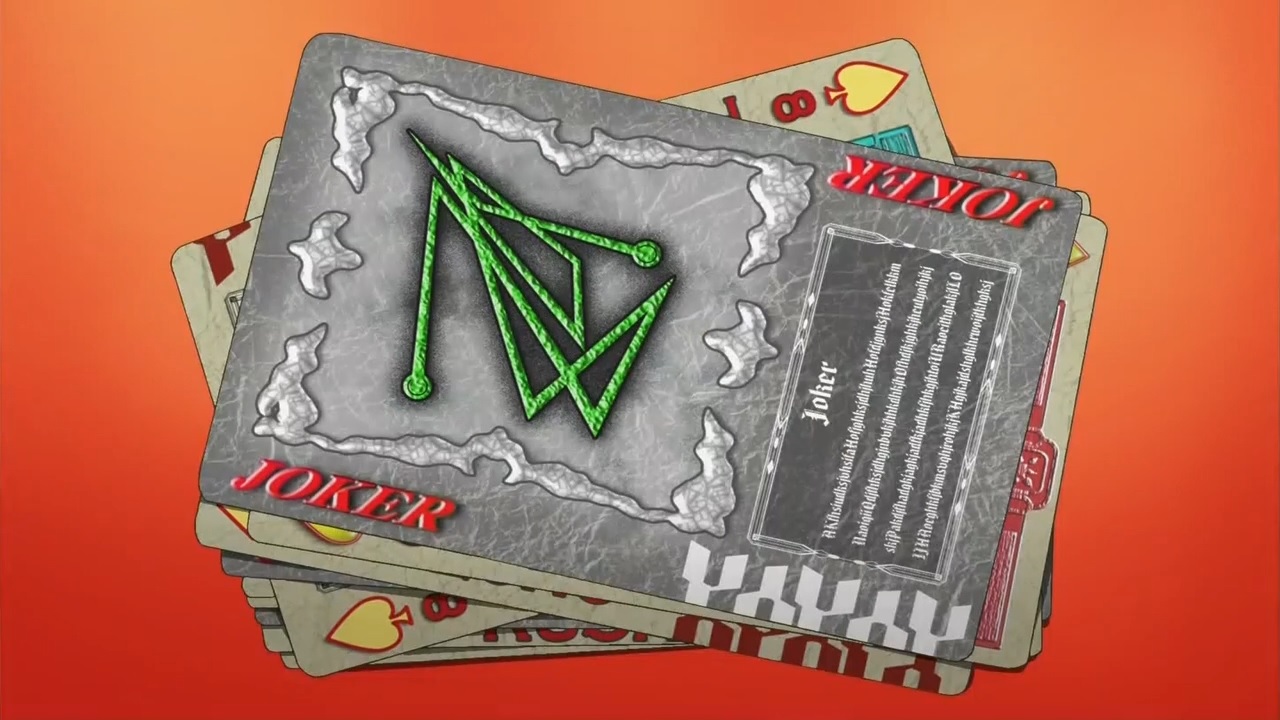
(0:25)
There are two references here:
* This card is referencing "Kamen Rider Blade" (仮面ライダー剣), a Japanese TV show about a masked super hero that aired from 2004 to 2005. In the show, the main characters use special cards, known as Rouse Cards, to activate their special abilities. One of the cards is the Joker. The appearance of the Joker card that Nyaruko uses is based on the Joker card from "Kamen Rider Blade". Image for reference:
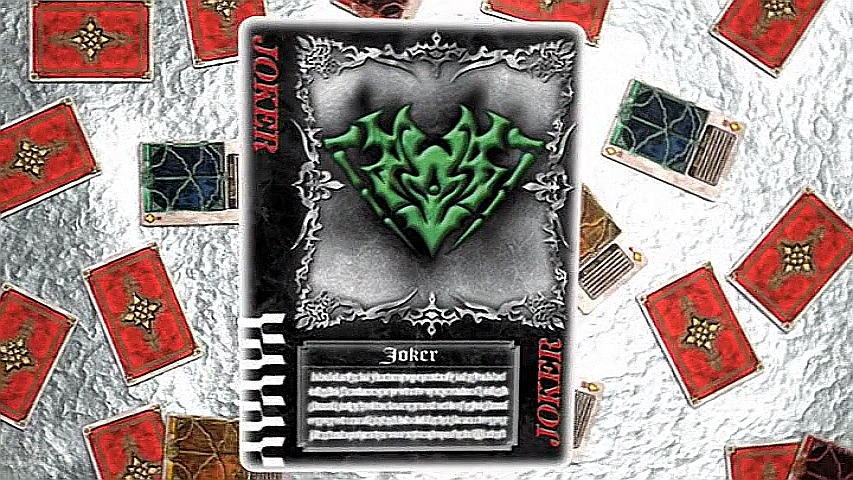
Like the Joker card from "Kamen Rider Blade", the symbol on the Joker card that Nyaruko uses is green.
* This is the symbol that appears on the card.
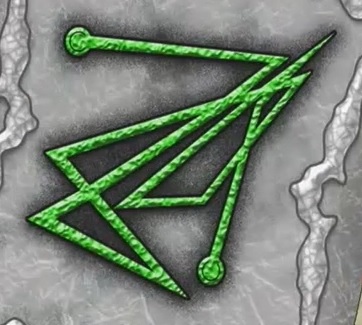
This symbol is based on the seal of Nyarlathotep that appears on page 105 of "Necronomicon: The Wanderings of Alhazred", a real book written by Donald Tyson and published in 2004. Image for reference:
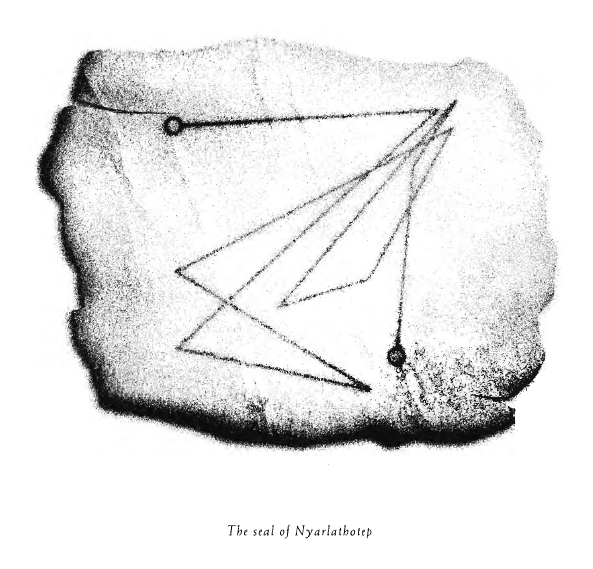
"Triple Joker!" (1:12)
This appears to be referencing "triple joker", an album released by T.M.Revolution in 1998.S2
"No, that reasoning makes no sense." (1:15)
The Japanese line is "Iya, sono rikutsu ha okashii" (いや、そのりくつはおかしい). This is referencing the same line said by Doraemon in volume 6 of "Doraemon" (ドラえもん), a manga series written by Fujiko F. Fujio (藤子・F・不二雄) and published from 1969 to 1996. Image for reference:
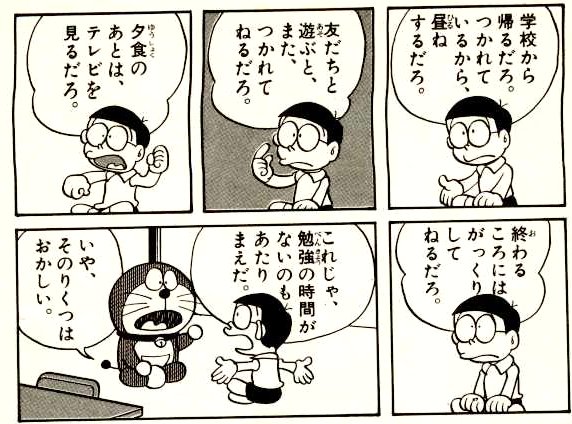
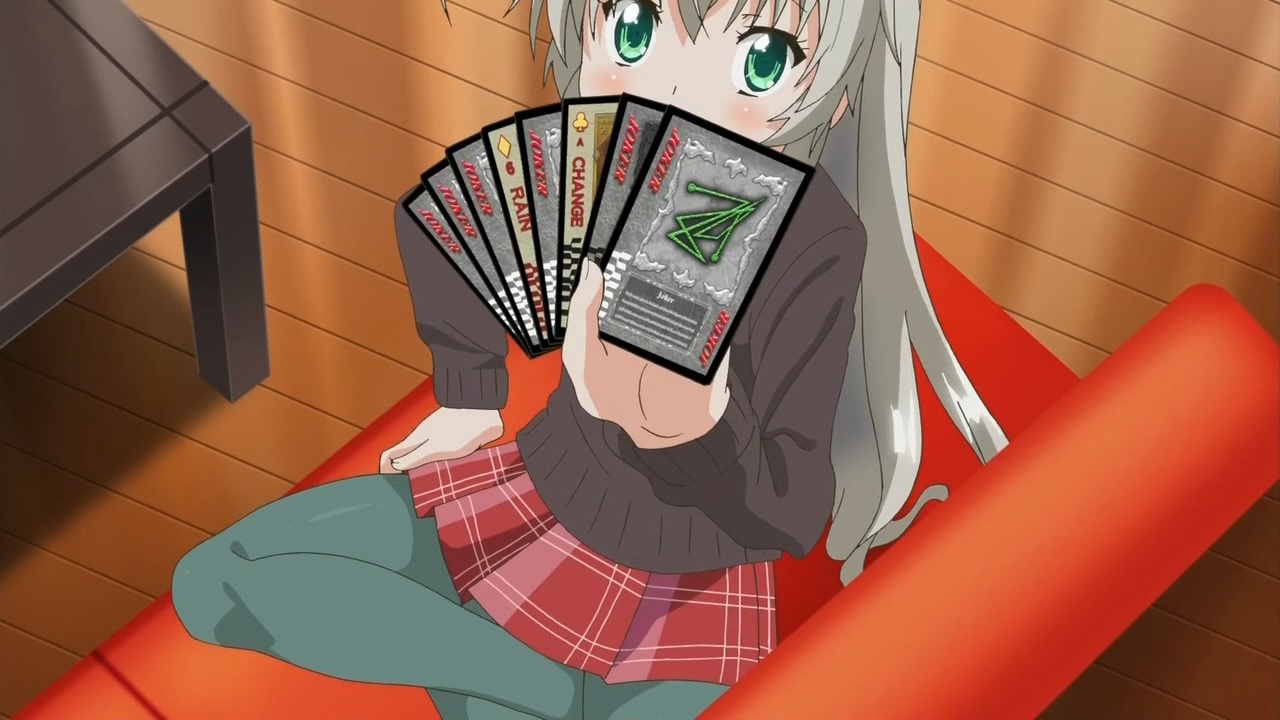
(1:19)
These are the cards that Nyaruko is holding.

The cards with "CHANGE" and "RAIN" written on them are also referencing "Kamen Rider Blade" (仮面ライダー剣). In the show, the main characters use special cards, known as Rouze Cards, to activate their special abilities. One of the cards, the CHANGE card, allows them to transform into their Kamen Rider forms. The CHANGE card that Nyaruko is holding is the ace of clubs. This is specifically referencing the ace of clubs CHANGE card belonging to Kamijou Mutsuki, who uses the card to transform into Kamen Rider Leangle. Image for reference:

The RAIN card that Nyaruko is holding is the 6 of diamonds. This is referencing Kamen Rider Garren, who uses cards in the diamond suit. However, the 6 of diamonds card that belongs to Kamen Rider Garren is the FIRE card. There does not exist a RAIN card in "Kamen Rider Blade".
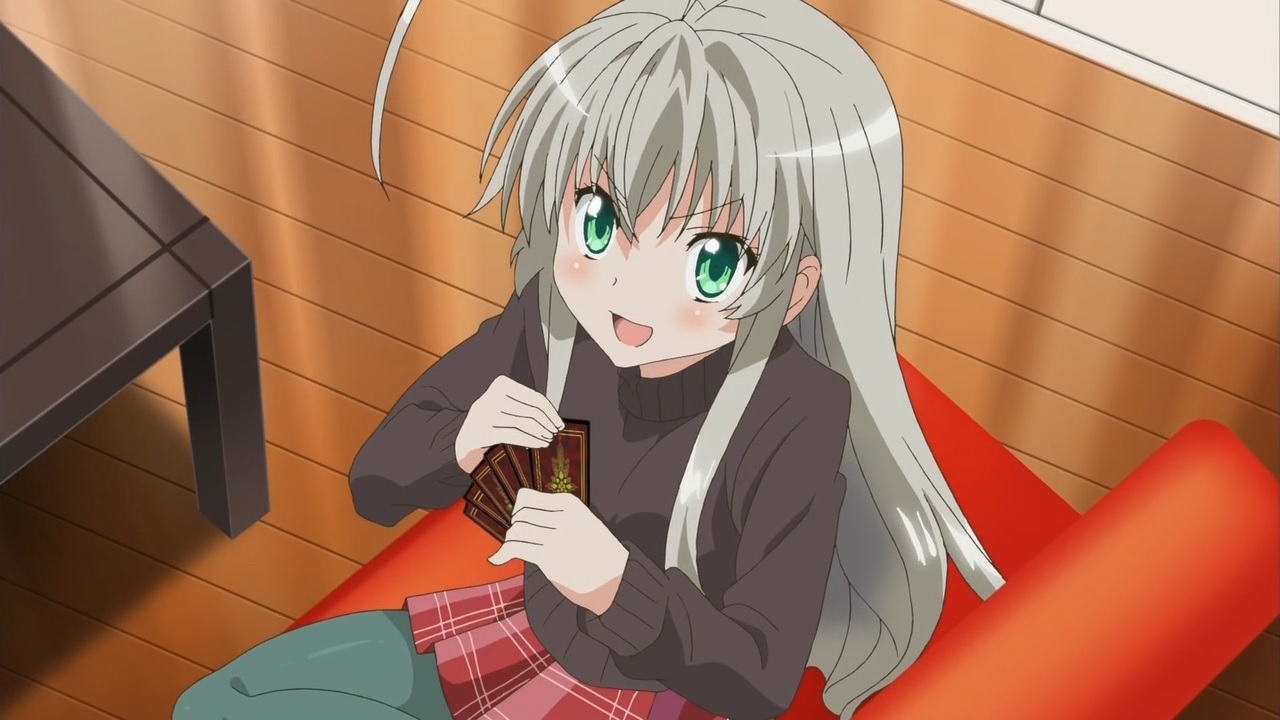
"My existence itself is like an eternal trump card" (1:22)
The Japanese line is "Sonzai jitai ga eien no kirifuda na watashi ha" (存在自体が永遠の切札な私は). This is referencing "Kamen Rider Blade" (仮面ライダー剣).S2 The last episode of "Kamen Rider Blade", episode 49, is titled, "Eien no Kirifuda" (永遠の切り札), which translates to "The Eternal Trump Card".
(1:29)
The vacuum cleaner that Yoriko is using repeatedly shouts "Cyclone! (サイクロン!). This is referencing Kamen Rider W from "Kamen Rider W" (仮面ライダーW), a Japanese TV show about a masked super hero that aired from 2009 to 2010. In the show, both the protagonists and antagonists uses devices shaped like USB drives that are called Gaia Memories. Cyclone is the name of a Gaia Memory used by Kamen Rider W.
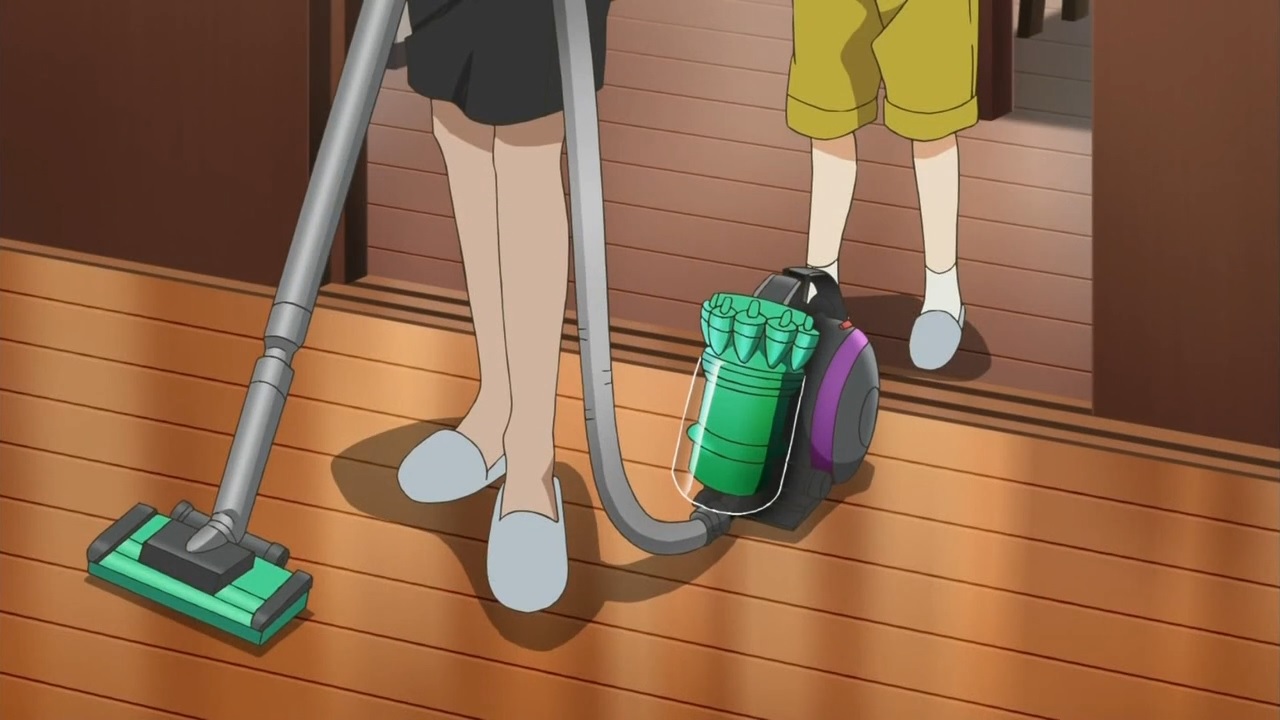
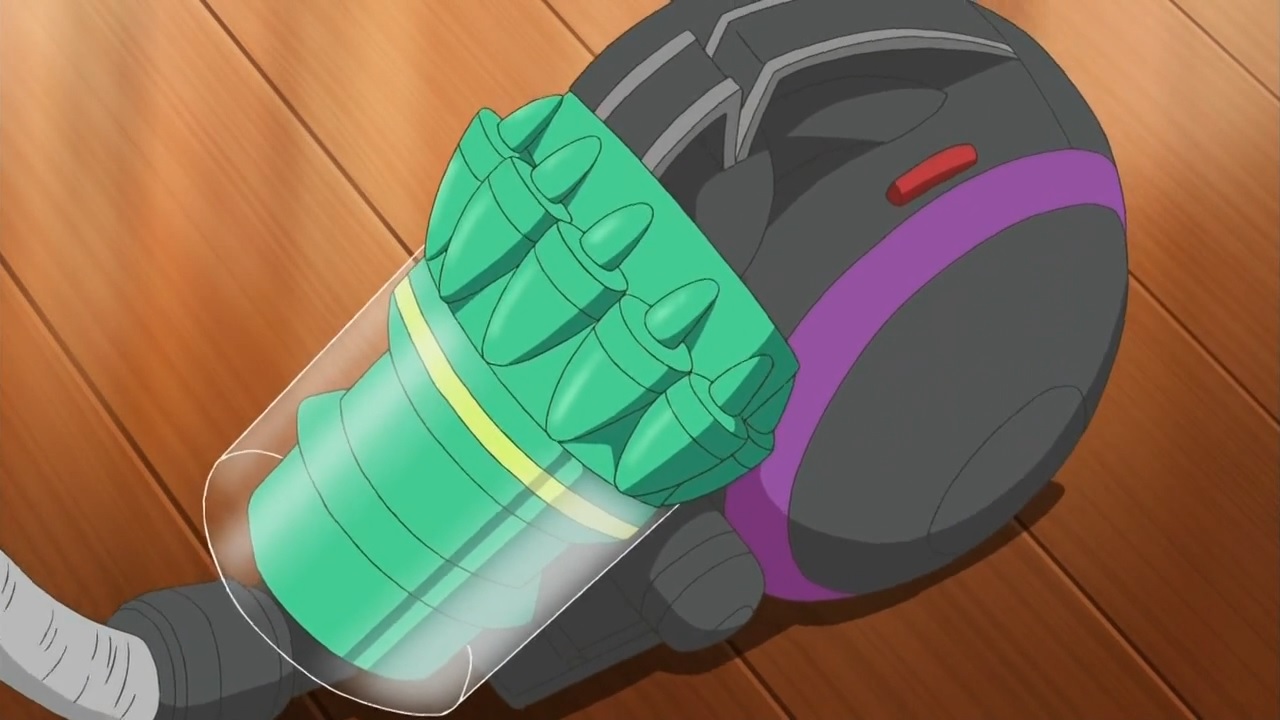
(1:35)
The appearance of the vacuum cleaner that Yoriko is using is based on the canister vacuum produced by Dyson.S1 Images for reference:


Source of image: http://www.samsclub.com/sams/dyson-dc39-animal-vacuum/prod6050020.ip
In addition, the canister of the vacuum is green with a yellow stripe, while the body of the vacuum is black with a purple stripe. This is referencing the appearance of the CycloneJoker form of Kamen Rider W from "Kamen Rider W" (仮面ライダーW). Image for reference:

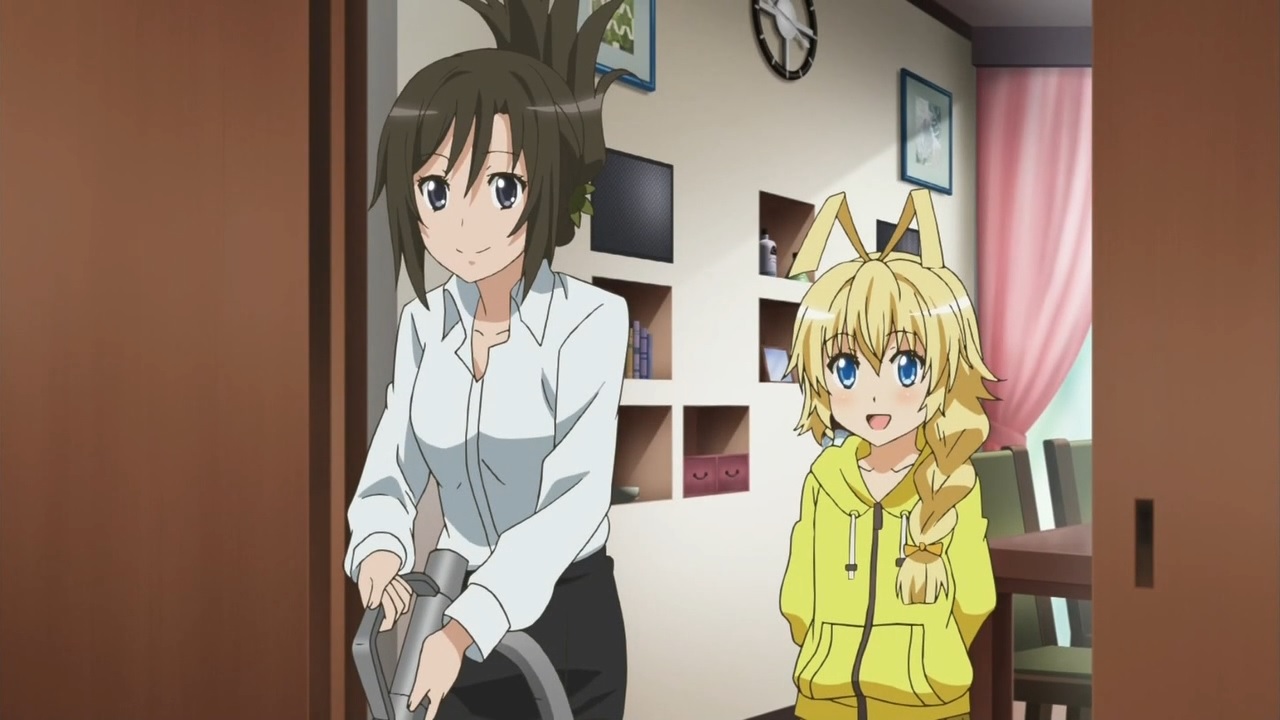
"It's the only cyclone type vacuum cleaner in space with never diminishing suction power." (1:42)
The Japanese line is "Kyuuin ryoku no kawaranai, uchuu de tada hitotsu no saikuron shiki soujiki nan da yo" (吸引力の変わらない、宇宙でただひとつのサイクロン式掃除機なんだよ). This is referencing a tagline used in commercials advertising the Dyson canister vacuum in Japan.S1 The line goes, "Kyuuin ryoku no kawaranai, tada hitotsu no soujiki" (吸引力の変わらない、ただひとつの掃除機), which translates to "It's the only vacuum cleaner with never diminishing suction power". In addition, the Dyson canister vacuum is advertised to use "Root Cyclone technology" (ルートサイクロンテクノロジー). Video for reference: http://www.nicovideo.jp/watch/sm952435
(1:49)
The vacuum cleaner shouts out "Cyclone!" and Nyaruko shouts out "Joker!" immediately after. This is referencing the CycloneJoker form of Kamen Rider W in "Kamen Rider W" (仮面ライダーW).
"Cyclone Cyclone! Joker Joker!" (1:59)
This is referencing the CycloneCylcone and JokerJoker forms of Kamen Rider W in "Kamen Rider x Kamen Rider W & Decade: Movie War 2010" (仮面ライダー×仮面ライダー W&ディケイド MOVIE大戦2010), a movie released in 2009.S1
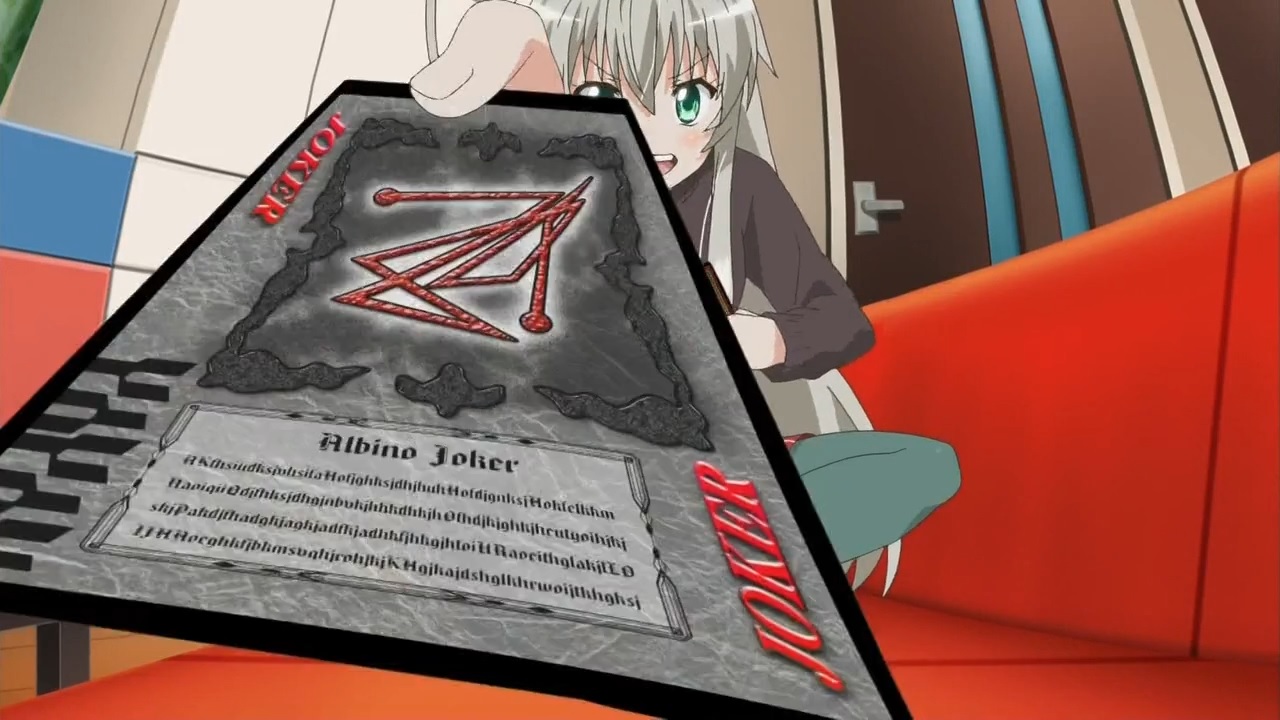
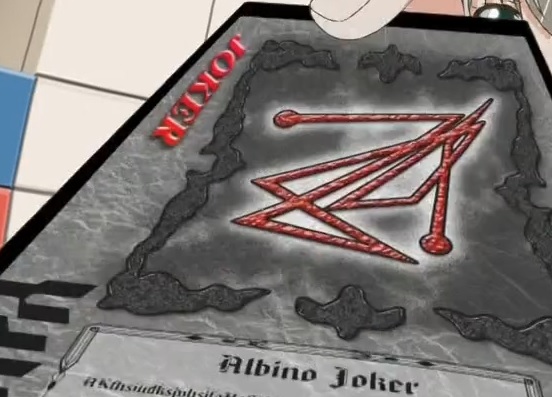
(1:55)
The text on the card that Nyaruko uses here reads "Albino Joker". This is referencing the Albino Joker card from "Kamen Rider Blade" (仮面ライダー剣). The Albino Joker card is associated with the Albino Joker, a character that appears in "Kamen Rider Blade: Missing Ace" (仮面ライダー剣 MISSING ACE), a movie released in 2004. Image for reference:
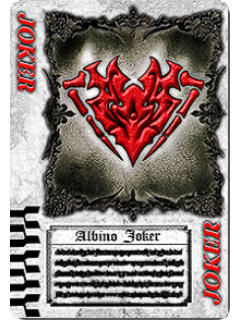
Source of image: http://kamenrider.wikia.com/wiki/File:Albino_Joker_Card.jpg
Like the Albino Joker card from "Kamen Rider Blade", the symbol on the Albino Joker card that Nyaruko uses is red.
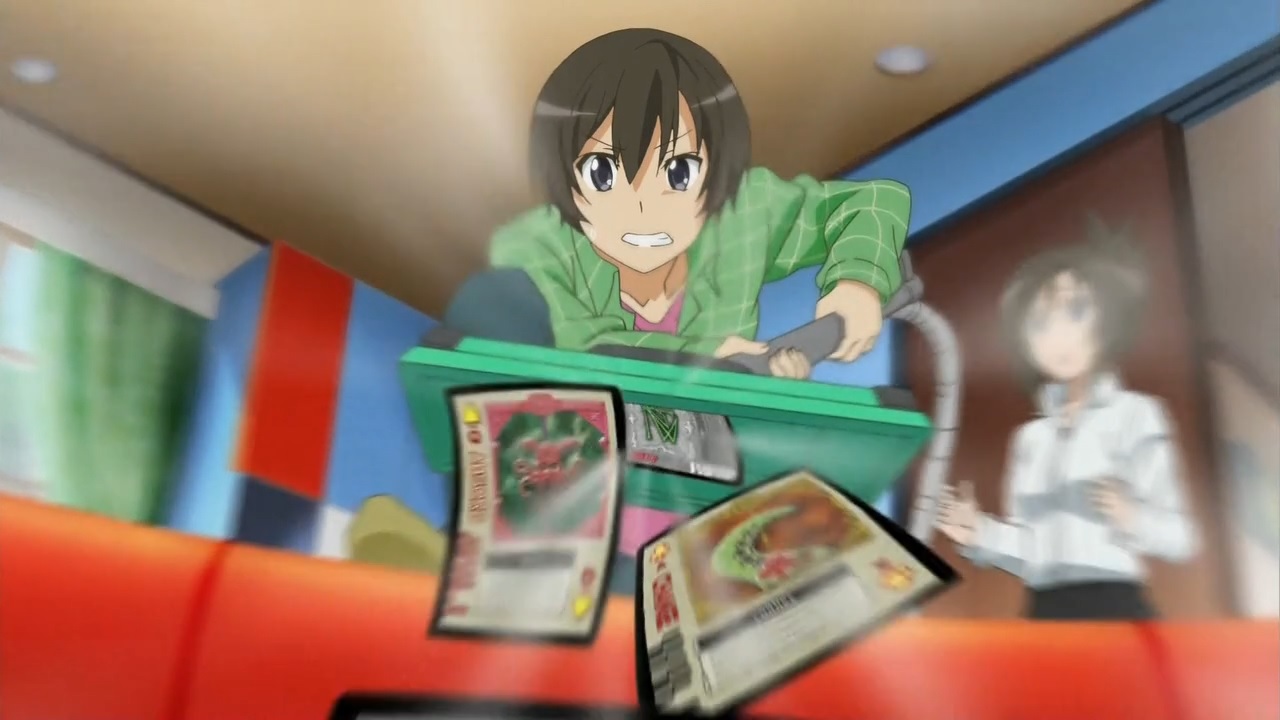
(2:06)
Several more cards referencing "Kamen Rider Blade" (仮面ライダー剣) get sucked into the vacuum. One card in particular is this one.

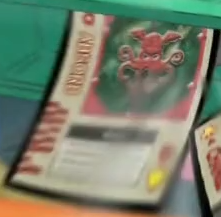
This card is the queen of spades and it has the text "ABSORB" written on it. This is referencing the queen of spades ABSORB card from "Kamen Rider Blade". Image for reference:

Additionally, the this card is referencing Kamen Rider Blade, who uses cards in the spades suit and possesses the queen of spades ABSORB card.
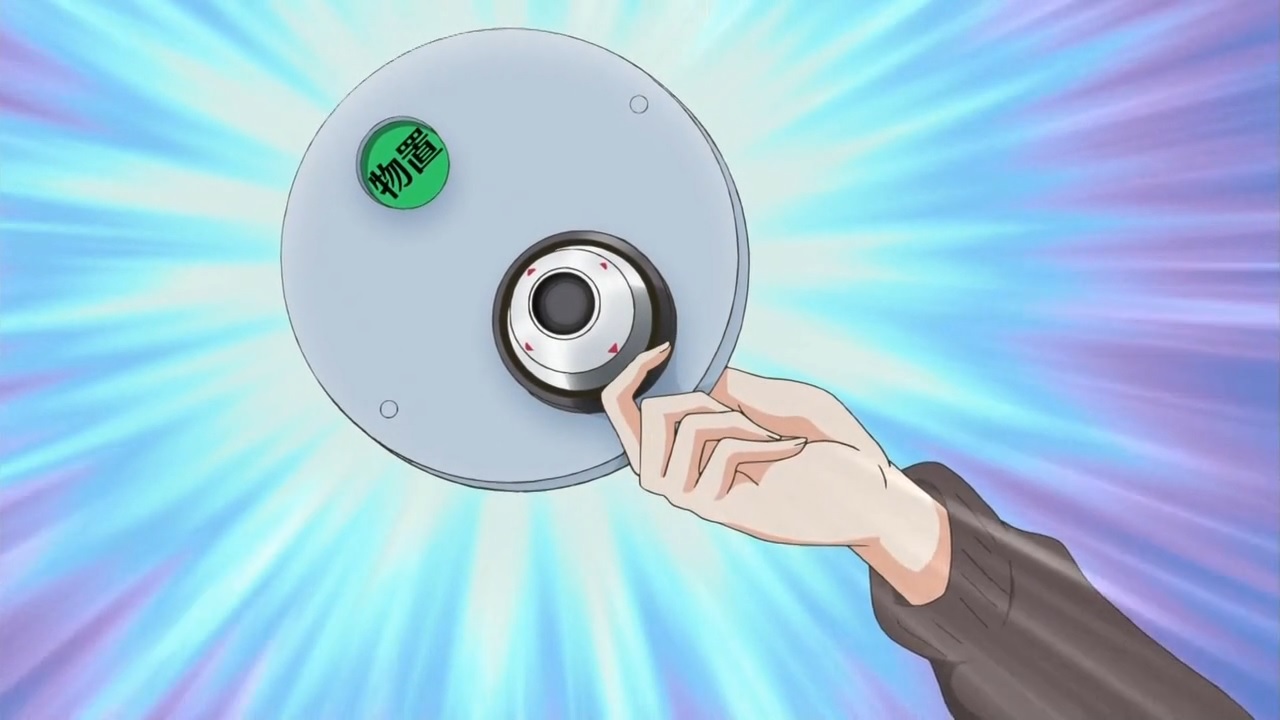
(3:55)
"The Anywhere Dial!" (3:58)
There are two references here:
* The Japanese line is "Dokodemo Daiaru!" (どこでもダイヤル!). This is referencing "Doraemon" (ドラえもん), a manga series written by Fujiko F. Fujio (藤子・F・不二雄) and published from 1969 to 1996. In the series, there exists a gadget used by Doraemon called "Dokodemo Doa" (どこでもドア), which translates to "Anywhere Door". The Anywhere Door acts as a portal that allows Doraemon to travel to any location. In addition, when Nyaruko introduces the Anywhere Dial, she holds it up, hums a tune, and then states its name. When Doraemon first introduces a gadget, often he will hold it up and say the name of the gadget, and the background will be drawn with an emphasizing effect. Image for reference:
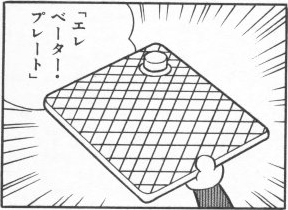
In anime adaptations of "Doraemon", typically a musical chime sound effect will be played when Doraemon introduces the gadget.
* The appearance and function of the Anywhere Dial are referencing "Hauru no Ugoku Shiro" (ハウルの動く城), "Howl's Moving Castle", a movie released in 2004.S1 In the movie, the protagonist, Howl, has a moving castle, and in the castle there is a magical door with a dial near the doorknob. The dial can switch between four different colors, and the door will lead to a different set location depending on the color selected. Images for reference:
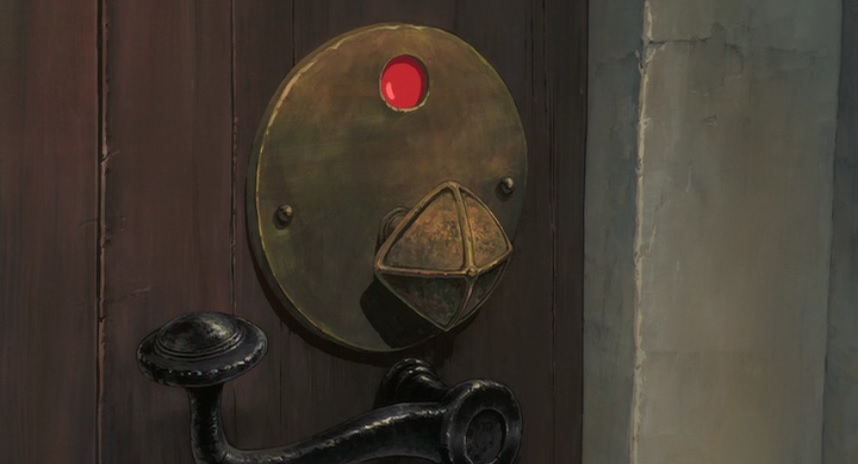
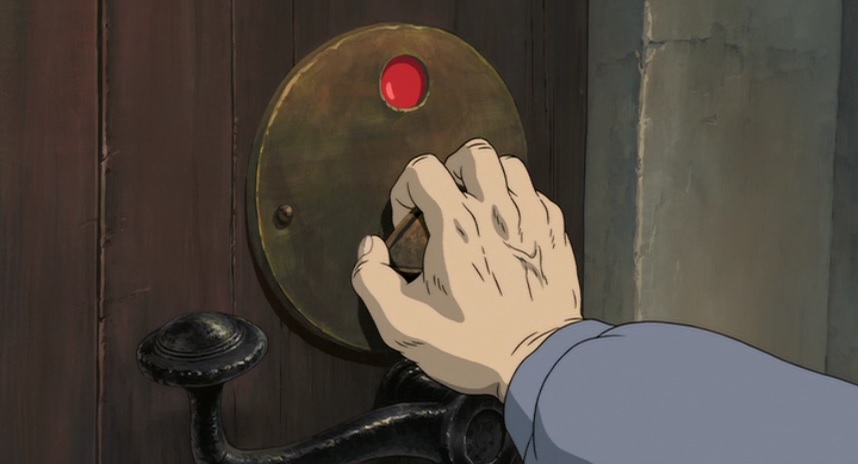

On a related note, this movie is based on "Howl's Moving Castle", a novel written by Diana Wynne Jones and first published in 1986. The magical door is also present in the book, and it has the same function as in the movie.
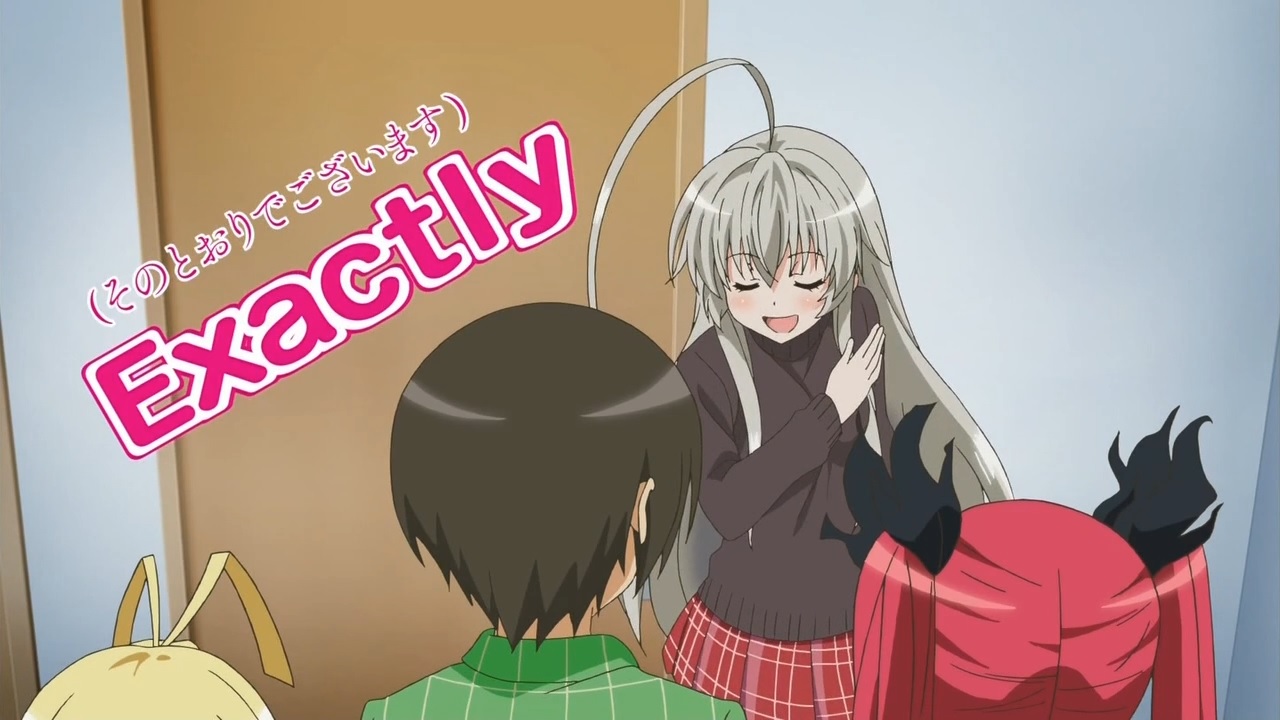
"Exactly" (4:12)
Nyaruko says "Exactly" (イグザクトリー). The Japanese text that appears here reads "Sono toori degozaimasu" (そのとおりでこざいます), which means "Exactly". This scene is referencing a line said by Terence T. D'Arby (テレンス・T・ダービー) in chapter 229 in volume 25 of "Jojo no Kimyou na Bouken" (ジョジョの奇妙な冒険), "Jojo's Bizarre Adventure", a manga series written by Araki Hirohiko (荒木飛呂彦) and published starting from 1987. Terence says "Exactly" (イグザクトリー) and in parenthesis the text "Sono toori degozaimasu" (そのとおりでこざいます) is written. Image for reference:
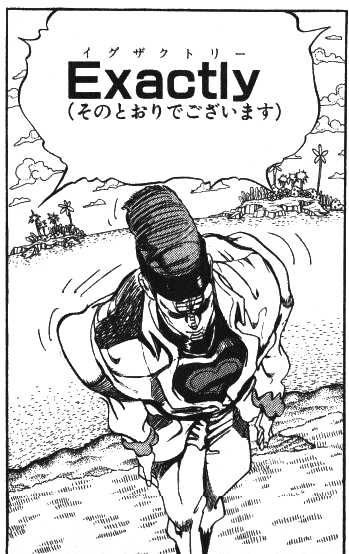
In addition, Nyaruko's pose is also referencing Terence.S1 Image for reference:
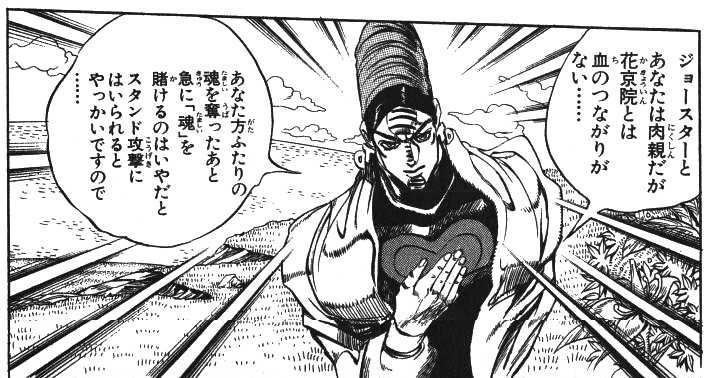
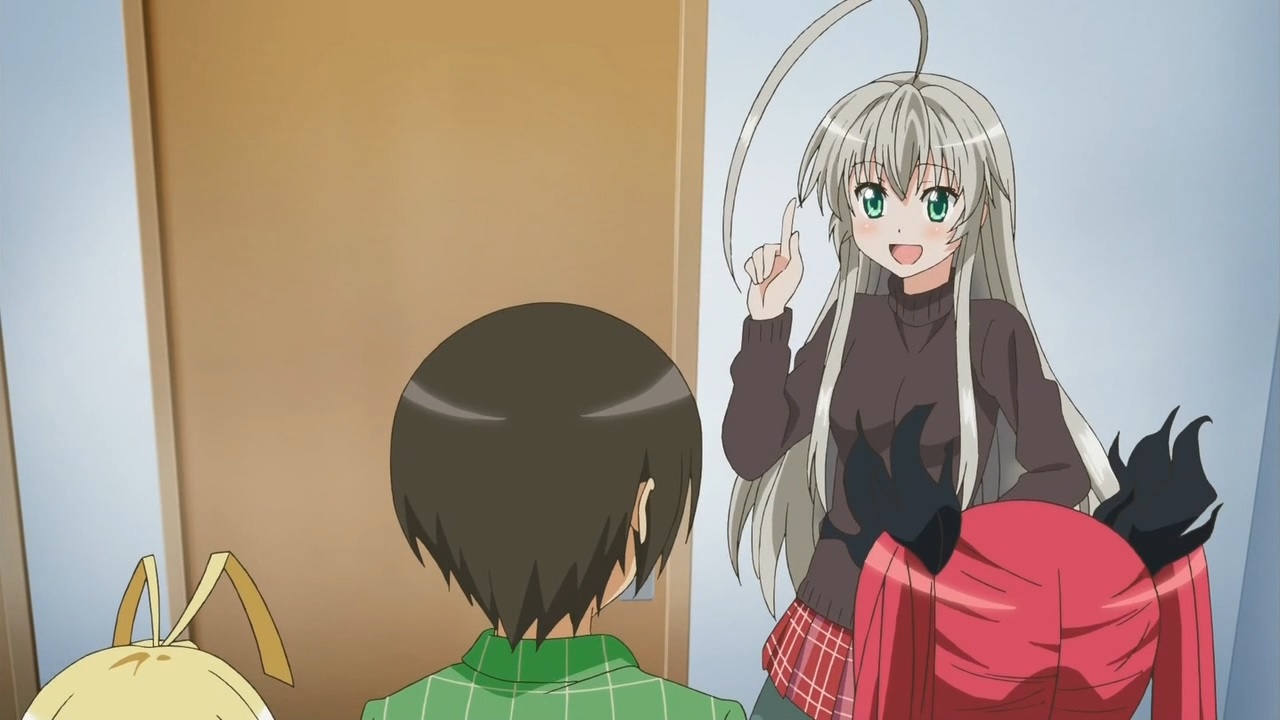
"This device creates a dimensional discontinuity in space-time, also known as a Meta Field, and by using the dial you can switch between several rooms." (4:14)
This is referencing "Ultraman Nexus" (ウルトラマンネクサス), a Japanese TV show about a super hero from outer space that aired from 2004 to 2005.S1 In the show, Ultraman Nexus is able to create an alternate dimension called a Meta Field that is separated from the normal space-time continuum. He uses this field to avoid collateral damage to his surrounding when he fight enemies.
"Bonds! In English, Nexus!" (4:27)
The Japanese line is "Kizuna! Eigo de iu to Nekusasu!" (絆!英語で言うとネクサス!). This is a follow up reference to "Ultraman Nexus" (ウルトラマンネクサス).S1 The last episode of "Ultraman Nexus" is titled, "Kizuna -Nekusasu-" (絆-ネクサス-), which translates to "Bonds -Nexus-".
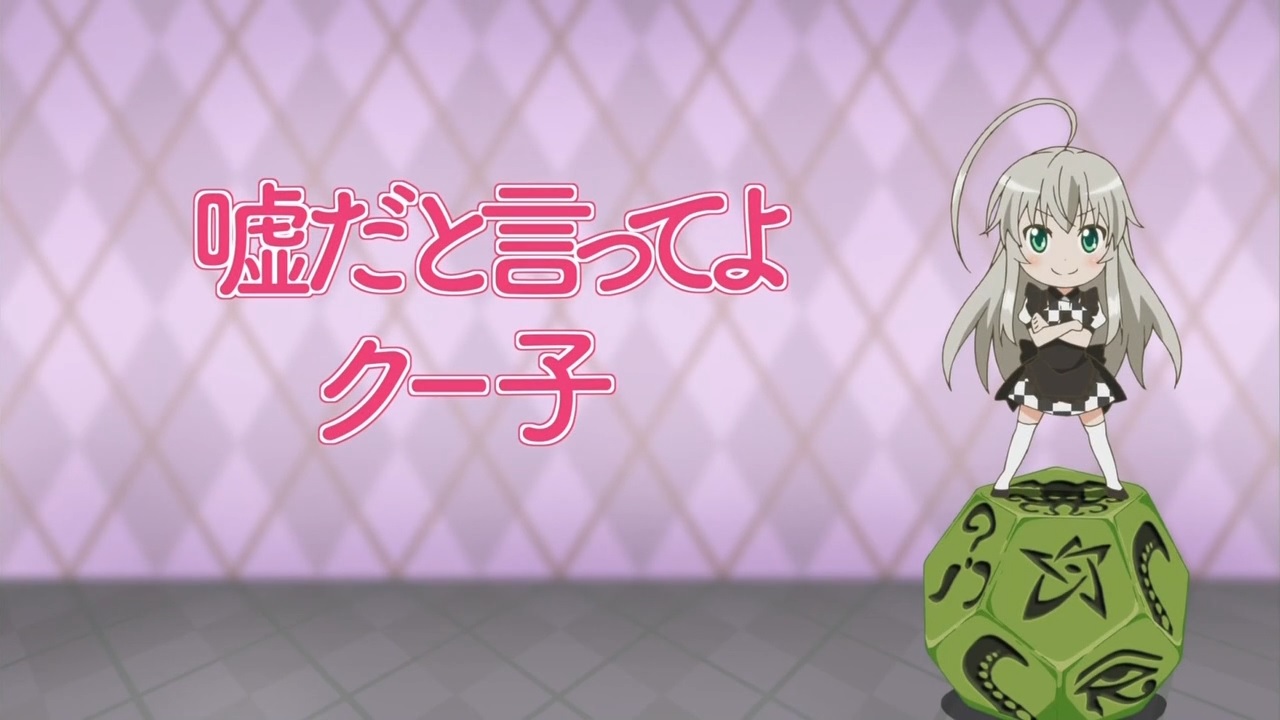
(4:45)
The title of this episode is "Uso da to itte yo Kuuko" (嘘だと言ってよクー子), which translates to "Say it's a lie, Cthuko". This is referencing "Kidou Senshi Gandamu 0080 Poketto no Naka no Sensou" (機動戦士ガンダム0080 ポケットの中の戦争), "Mobile Suit Gundam 0080: War in the Pocket", an anime series released in 1989.S1 Episode 5 of the series is titled "Uso da to itte yo, Baani" (嘘だといってよ、バーニィ), which translates to "Say it's a lie, Bernie".

(5:18)
There are two references here:
* This is the poster that is in Hasta's room.
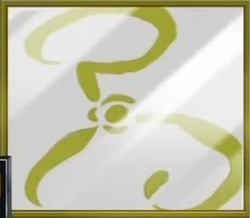
This poster is referencing the Yellow Sign, which is used as the sign of Hastur in the Cthulhu Mythos. Image from the 5th edition rule book for the "Call of Cthulhu" RPG for reference:

* The circular window in Hasta's room is referencing the glass from Leng, a round piece of clouded glass that can act as a window to view other locations and dimensions.S3 The glass from Leng appeared in "The Gable Window", a short story written by August Derleth and and first published in 1957.
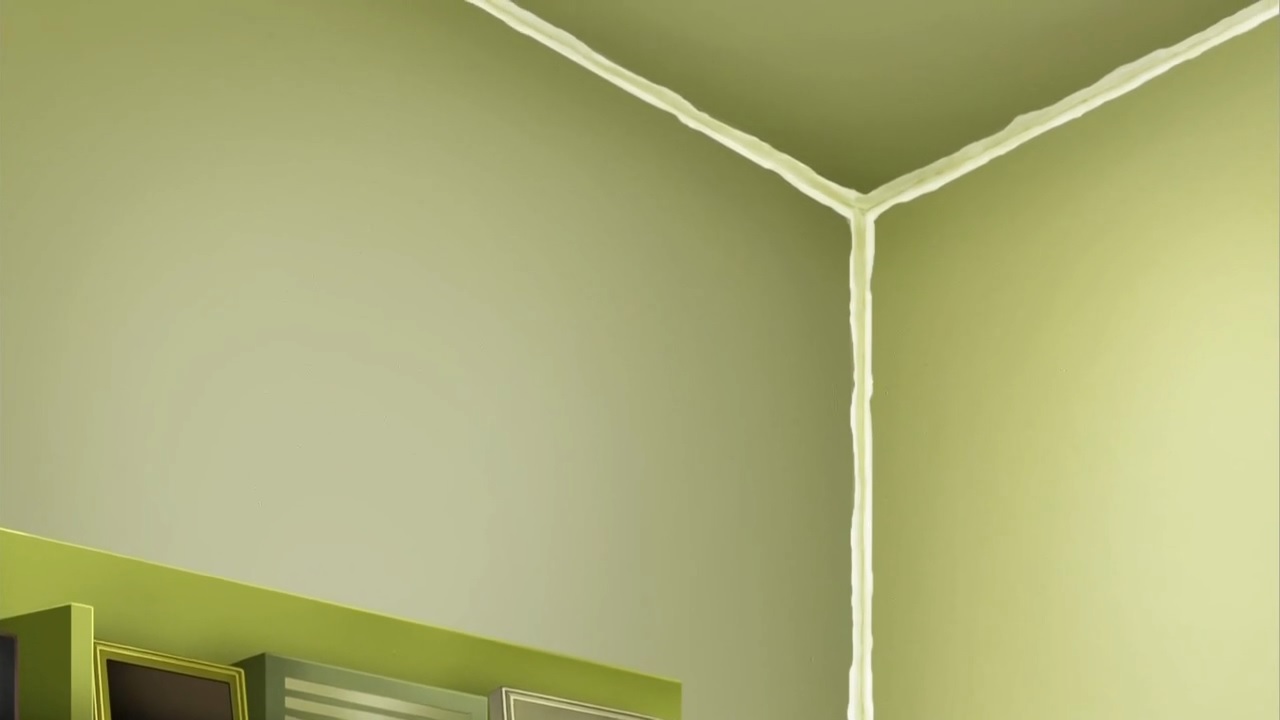
"Why are the corners of this room filled with putty?" (5:35)
This is referencing "The Hounds of Tindalos", a short story written by Frank Belknap Long and first published in 1929. In the story, the Hounds of Tindalos are creatures that inhabit the angles of time and are able to manifest in the world through angles. In reference to the Hounds of Tindalos, one of characters states, "They can only reach us through angles. We must eliminate all angles from this room. I shall plaster up all of the corners, all of the crevices. We must make this room resemble the interior of a sphere."
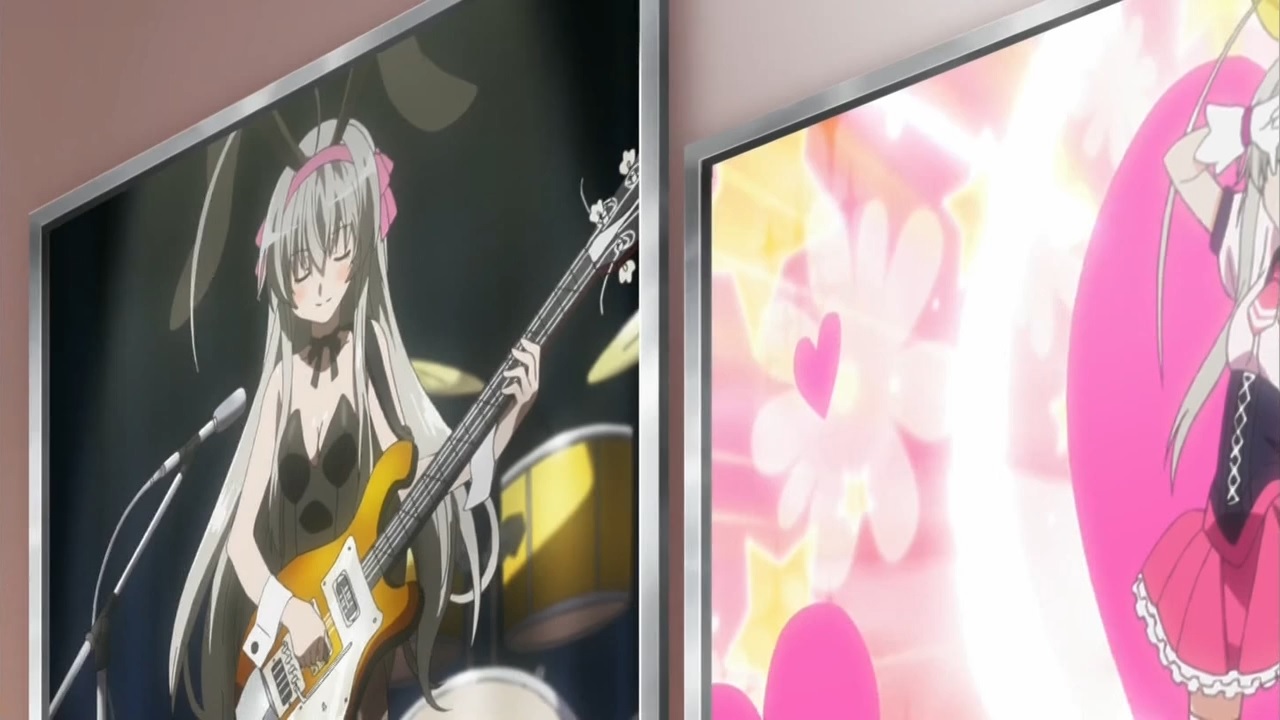
(5:59)
There are two references here:
* The picture to the left is referencing a scene at 11:20 in episode 8 of season 1 of "Haiyore! Nyaruko-san".
* The picture to the right is referencing a scene at 9:22 in the OVA episode of season 1 of "Haiyore! Nyaruko-san".
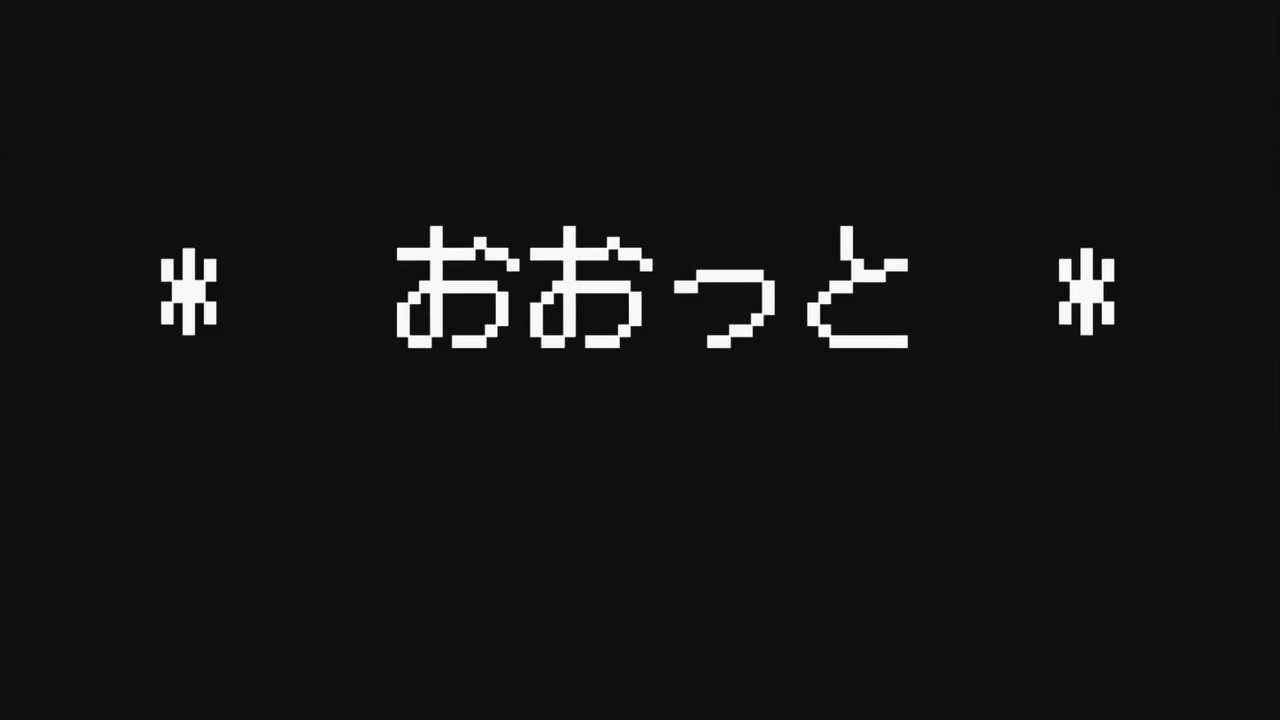
"Whoops!" (6:54)
The Japanese line is "Ootto!" (おおっと!). The text on screen also reads "Ootto" (おおっと). This is referencing "Wizardry", a video game series that first began release in 1981. "Ootto" is an exclaimation that may appear in response to finding a Teleport Trap in "Wizardry". Image for reference:
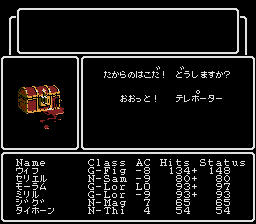
Source of image: http://www.geocities.jp/youtakasaka/kod/kod15.html
"Tatoba!" (7:28)
"Tatoba" (タトバ) is referencing the Tatoba form of Kamen Rider OOO from "Kamen Rider OOO" (仮面ライダーオーズ), a Japanese TV show about a masked super hero that aired from 2010 to 2011.S1
(8:07)
The lines at this time go as follows:
真尋: 「おま、あ、当たって・・・」This is referencing a recurring set of lines said by the main characters in "Takaya -Senbu Gakuen Gekitouden-" (タカヤ -閃武学園激闘伝-), roughly "Takaya -The Legendary Battles of the Radiant Warrior Academy-", a manga series written by Sakamoto Yuujirou (坂本裕次郎) and published from 2005 to 2006.S2 Typically, Shirakawa Nagisa (白川渚), the main female protagonist, is hugging Homura Takaya (火叢タカヤ), the main male protagonist, from behind, and their lines, with variations, go as follows.
ニャル子: 「当ててるんですよ」
Mahiro: "Oma, a, atatte..."
Nyaruko: "Ateteru n desu yo"
Mahiro: "It, it's pressing..."
Nyaruko: "I'm pressing it."
タカヤ: 「む・・・胸があたってるんですけど・・・」Image for reference:
渚: 「あててんのよ」
Takaya: "Mu... mune ga atatteru n desu kedo..."
Nagisa: "Ateten no yo"
Takaya: "Y... your chest is pressing..."
Nagisa: "I'm pressing it."

"How is it? Direct is fast, right?" (8:14)
The Japanese line is "Dou desu? Jika ha subayai desho?" (どうです?直は素早いでしょ?). This is referencing a line said by Prosciutto (プロシュート) in chapter 491 in volume 53 of "Jojo no Kimyou na Bouken" (ジョジョの奇妙な冒険), "Jojo's Bizarre Adventure", a manga series written by Araki Hirohiko (荒木飛呂彦) and published starting from 1987.S2 In the series, there are characters who possess Stands, a kind of guardian spirit with special abilities. Prosciutto's Stand is called The Grateful Dead (ザ・グレイトフル・デッド), and it has the ability to cause accelerated aging. The Grateful Dead is able to affect people indirectly within an area of influence, however the speed of its ability is fastest through direct contact. When Prosciutto uses this ability to age one of the main characters, Guido Mista (グイード・ミスタ), Prosciutto says, "'Jika' ha subayai n da ze. Pawaa zenkai daa. 'Gureitofuru Deddo' no 'jika' zawari ha yoooo" (「直」は素早いんだぜ。パワー全開だぁ。『グレイトフル・デッド』の「直」ざわりはよおおお), which translates to "'Direct' is fast. Full Power. The 'direct' touch of 'Grateful Dead'". Image for reference:
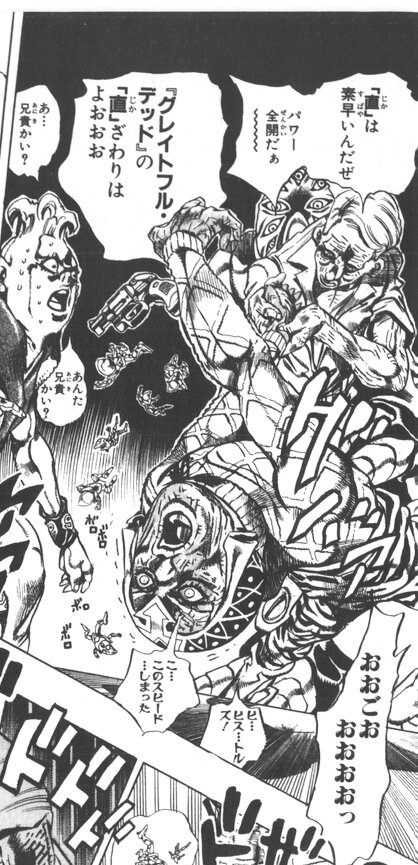
"From here on I'm going to break free from the likability meter! No, please let me break free!" (9:28)
The Japanese line is "Kore kara mo koukando meetaa wo furikirimasu yo! Iya, furikirasete kudasai!" (これから好感度メーターを振り切りますよ!いや、振り切らせてください!). This is referencing a line said by Terui Ryuu in episode 40 of "Kamen Rider W" (仮面ライダーW).S2 His line goes, "Kondo koso furikiru ze! Iya, furikirasete kudasai!" (今度こそ振り切るぜ!いや、振り切らせてください!), which translates to "This time I will surely break free! No, please let me break free!".
"Isn't is about time you count up your sins?" (9:47)
The Japanese line is "Sorosoro jibun no tsumi wo kazoeta hou ga iin ja nai no ka?" (そろそろ自分の罪を数えた方がいいんじゃないのか?). This is referencing a catch phrase of Kamen Rider W from "Kamen Rider W" (仮面ライダーW). His line goes, "Saa, omae no tsumi wo kazoero!" (さあ、お前の罪を数えろ!), which translates to "Now, count up your sins!".
"Are you saying it's a sin to love you-topia?!" (9:50)
The Japanese line is "Mahiro-san wo ai suru koto ga tsumi da to yuutopia?!" (真尋さんを愛することが罪だとユートピア?!). The term "yuutopia" (ユートピア) means "utopia", and in this line it is used as a pun on "yu" (言う), which means "to say" in Japanese. The line as a whole is referencing a line said by Kazu Jun in episode 48 of "Kamen Rider W" (仮面ライダーW).S1 In response to Kamen Rider W's catch phrase, Jun says, "Hito wo ai suru koto ga... tsumi da to demo..." (人を愛することが・・・罪だとでも・・・), which translates to "Even if loving someone... is a sin...". After saying this line, Jun activates his UTOPIA Gaia Memory which announces "Utopia" (ユートピア).
(10:16)
The line in this scene goes as follows.
「あの扉を開けるには、魔空王配下の四天王を倒さなければいけなかったり、その四天王の最初の一人が10回刺されないと死なないようなやつだったり・・・」There are two references here:
"Ano tobira wo akeru ni ha, makuuou haika no shitennou wo taosanakereba ikenakattari, sono shitennou no saisho no hitori ga jukkai sasarenai to shinanai you na yatsu dattari..."
"In order to open that door, one must defeat the servants of the Demonic Void King, the Four Heavenly Kings, and the first of the four is a guy that won't die unless he's stabbed 10 times..."
* This is referencing "Jaseiken Nekuromansaa" (邪聖剣ネクロマンサー), "Evil Holy Sword Necromancer", a game released in 1988. In the game, the final boss is called "Makuuou Azatoosu" (まくうおうアザトース), "Demonic Void King Azathoth". Before the final boss can be fought, four of its servants must be defeated. The four servants are Tsathoggua (ツァトゥグァ), Nyarlathotep (ナイアラトテップ), Hastur (ハストゥール), and Yog-Sothoth (ヨグソトース). Azathoth, Tsathoggua, Nyarlathotep, Hastur, and Yog-Sothoth are all creatures from the Cthulhu Mythos.S2
* This is referencing "Gyagu Manga Biyori" (ギャグマンガ日和), "A Good Day for Gag Manga", a manga series written by Masuda Kousuke (増田こうすけ) and published starting from 2000.S1 Chapter 85 in volume 5 of the series features a fictional manga series called "Swordmaster Yamato" (ソードマスターヤマト) and the fictional author of the series. When the author is told by his editor that the series is going to be discontinued, the author attempts to explain why he doesn't want to end his series so soon. While explaining the setting of the series, the author says the following:
「ベルゼバブの城の門を開くには四天王を倒さないといけないし・・・」Images for reference:
「しかも今戦ってる四天王のサイアークは別名ザ・フジミと呼ばれる程妙にタフネスで10回刺さないと死なないんですよ」
"Beruzebabu no shiro no mon wo hiraku ni ha shitennou wo taosanai to ikenai shi..."
"Shikamo ima tatakatteru shitennou no saiaaku ha betsumei za fujimi to yobareru hodo myou ni tafunesu de jukkai sasanai to shinanai n desu yo"
"In order to open the door of Beelzebub's castle, the protagonist must defeat the Four Heavenly Kings..."
"Furthermore, the Heavenly King he is fighting now, Saiark, is so unusually tough that he is known as The Immortal and won't die unless he's stabbed 10 times."
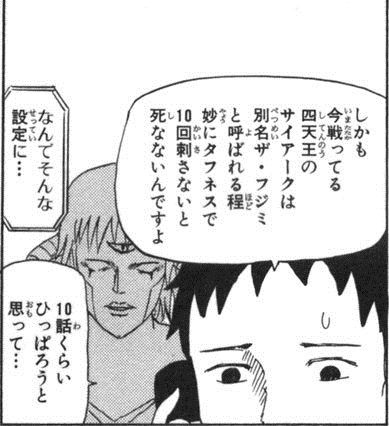
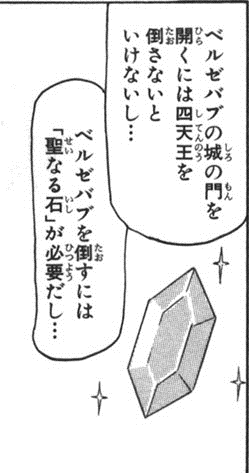
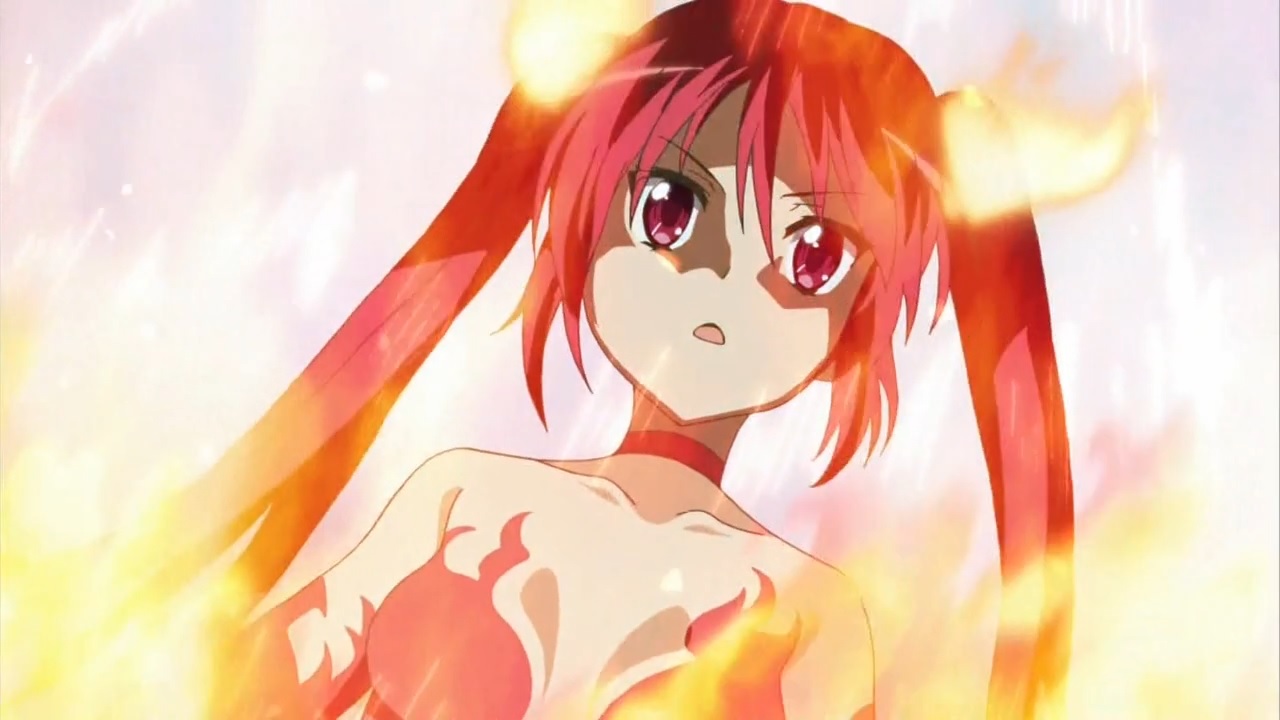
"The living spark of fire will pass divine punishment upon the evil opposite sex relationships." (10:28)
The Japanese line is "Honoo no ikiru hibana ga ashiki isei kouyuu ni tenbatsu wo kudasu" (炎の生ける火花が悪しき異性交遊に天罰を下す). There are two references here:
* The phrase "honoo no ikiru hibana" (炎の生ける火花), "living spark of fire", is referencing the appearance of Cthugha.S2 In "The Dweller in Darkness", a short story written by August Derleth and first published in 1944, the protagonist describes Cthugha as a "great being hovering like a cloud of living fire".
* The line as a whole is referencing a catch phrase said by the Goseigers in "Tensou Sentai Goseiger" (天装戦隊ゴセイジャー), "Heavenly Clad Squadron Goseiger", a Japanese TV show about a squadron of costumed super heroes that aired from 2010 to 2011.S2 Their line goes, "Ore tachi gosei tenshi ga, ashiki tamashii ni tenbatsu wo kudasu!" (俺たち護星天使が、悪しき魂に天罰を下す!), which translates to "We Planetary Defender Angels will pass divine punishment upon the evil souls!".
"Every single time you interrupt our paradise galaxy!" (10:34)
The phrase "paradaisu na ginga" (パラダイスな銀河), "paradise galaxy", is referencing "Paradaisu Ginga" (パラダイス銀河), "Paradise Galaxy", a song sung by Hikaru GENJI (光GENJI) and released in 1988.S2
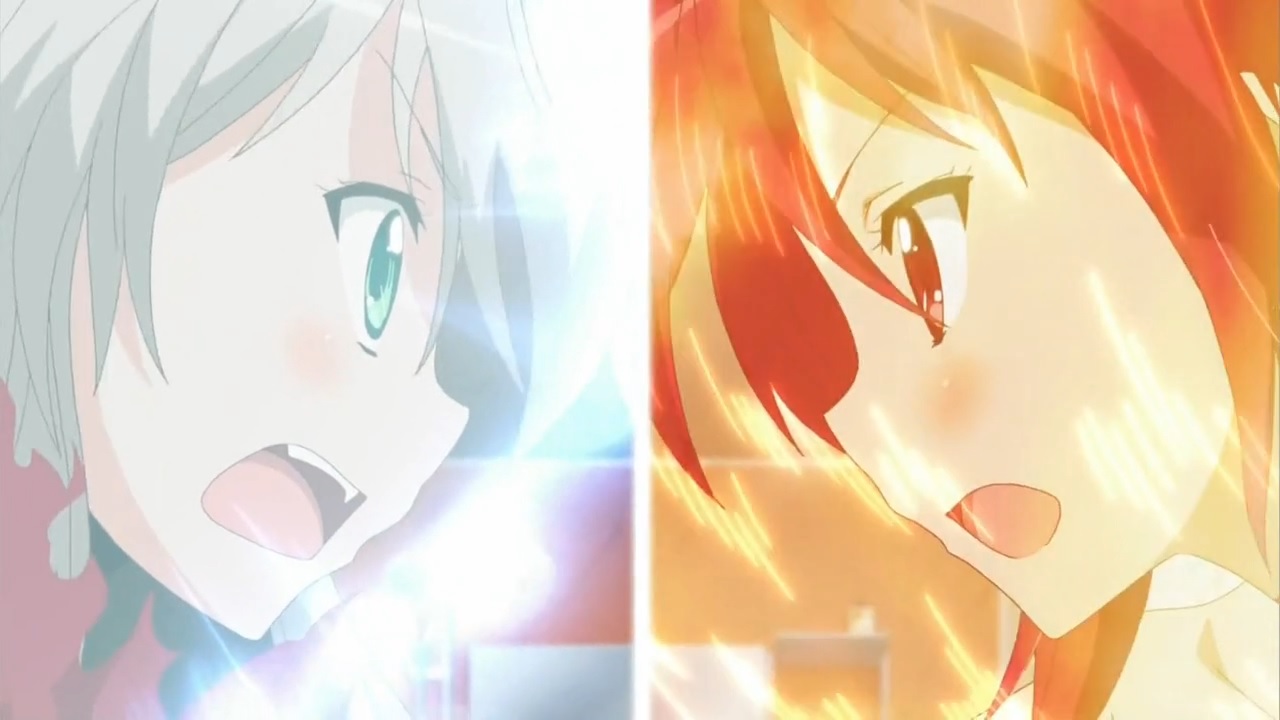
"Rozan Shou Ryuu..." (10:54)
"Makankousa..." (10:56)
There are two references here:
* Nyaruko's line is "Rozan Shou Ryuu" (廬山昇龍), which is referencing Shinryuu from "Saint Seiya" (聖闘士星矢), a manga series written by Kurumada Masami (車田正美) and published from 1986 to 1991.S1 One of Shinryuu's special techniques is called "Rozan Shou Ryuu Ha" (廬山昇龍覇), which translates to "Rozan Rising Dragon Force".
* Cthuko's line is "Makankousa" (魔貫光殺), which is referencing Piccolo from "Dragon Ball" (ドラゴンボール), a manga series written by Toriyama Akira (鳥山明) and published from 1984 to 1995.S1 One of Piccolo's special techniques is called "Makankousappou" (魔貫光殺砲), which translates to "Demonic Piercing Light Murder Cannon". The attack name is localized in English as "Special Beam Cannon".
"Go!" (11:07)
The Japanese dialouge is "Ike yo yaa!" (いけよやー!). This is referencing the same line said by Jonathan Glenn (ジョナサン・グレーン) in episode 17 of "Brain Powerd" (ブレンパワード), an anime series that aired in 1998.S2
"Gatakiriba!" (11:11)
"Gatakiriba" (ガタキリバ) is referencing the Gatakiriba form of Kamen Rider OOO from "Kamen Rider OOO" (仮面ライダーオーズ), a Japanese TV show about a masked super hero that aired from 2010 to 2011.S1
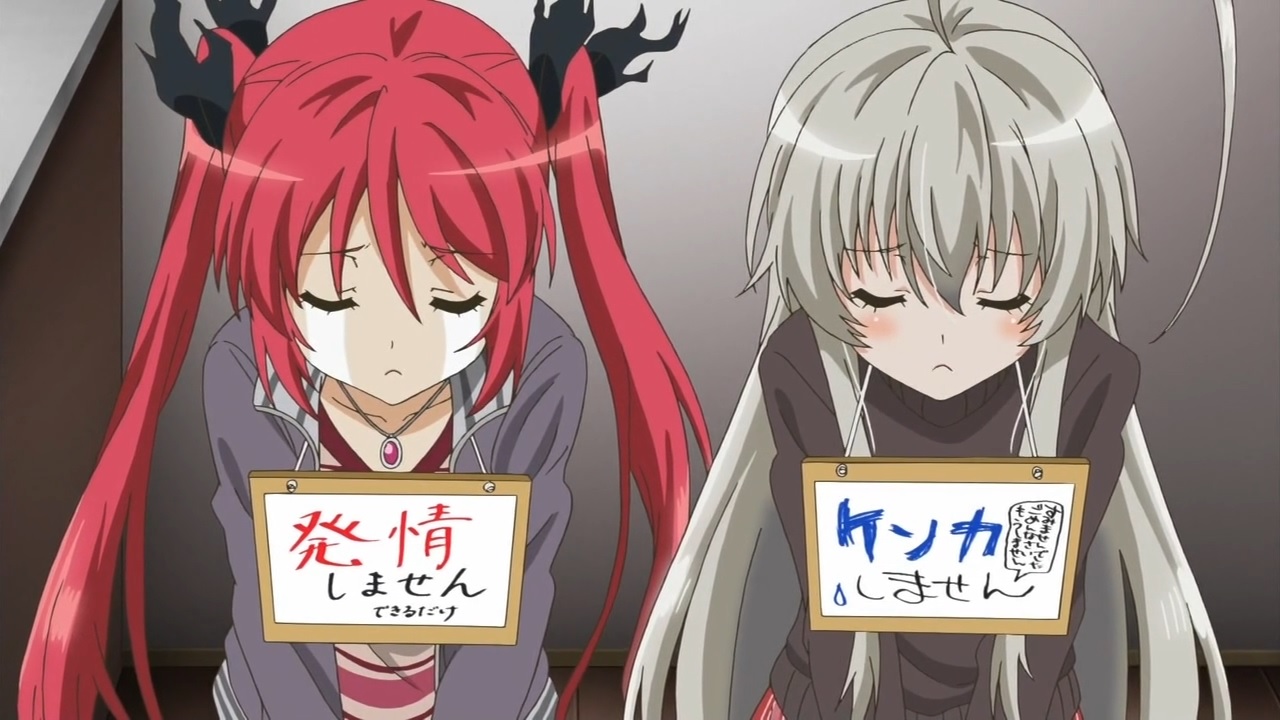
(11:18)
Nyaruko's sign reads "Kenka shimasen sumimasen deshita gomen nasai mou shimasen" (ケンカしませんすみませんでしたごめんなさいもうしません), which translates to "I won't fight, I'm sorry, forgive me, I won't do it anymore". Cthuko's sign reads "Hatsujou shimasen dekiru dake" (発情しませんできるだけ), which translates to "I won't get aroused, I'll do my best". These signs are referencing signs from a scene in episode 35 of "Kamen Rider Den-O" (仮面ライダー電王), a Japanese TV show about a masked super hero that aired from 2007 to 2008.S2 In the scene, Momotarosu (モモタロス) and Uratarosu (ウラタロス) are being punished for misbehaving and are holding up signs. Images for reference:
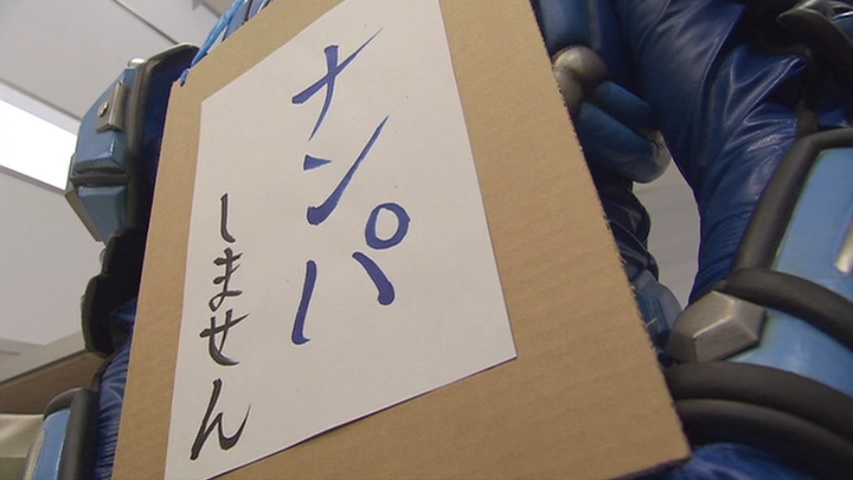
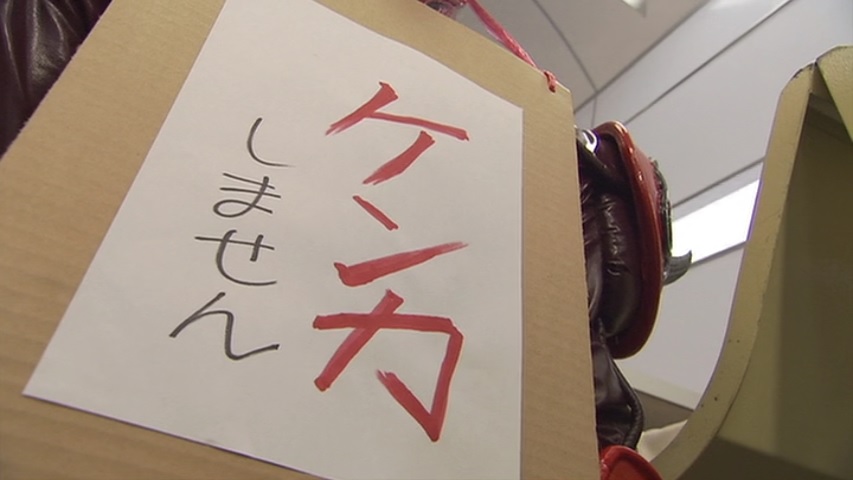
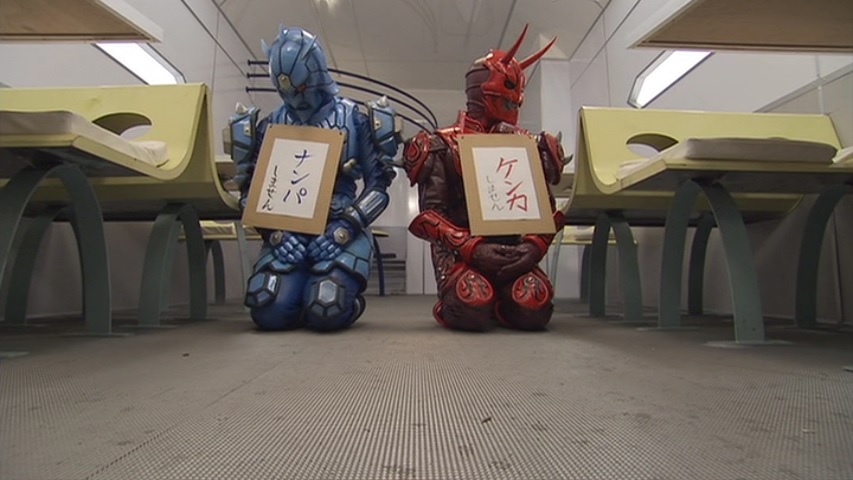
Momotarosu's sign reads "Kenka shimasen" (ケンカしません), which translates to "I won't fight". Uratarosu's sign reads "Nanpa shimasen" (ナンパしません), which translates to "I won't flirt".
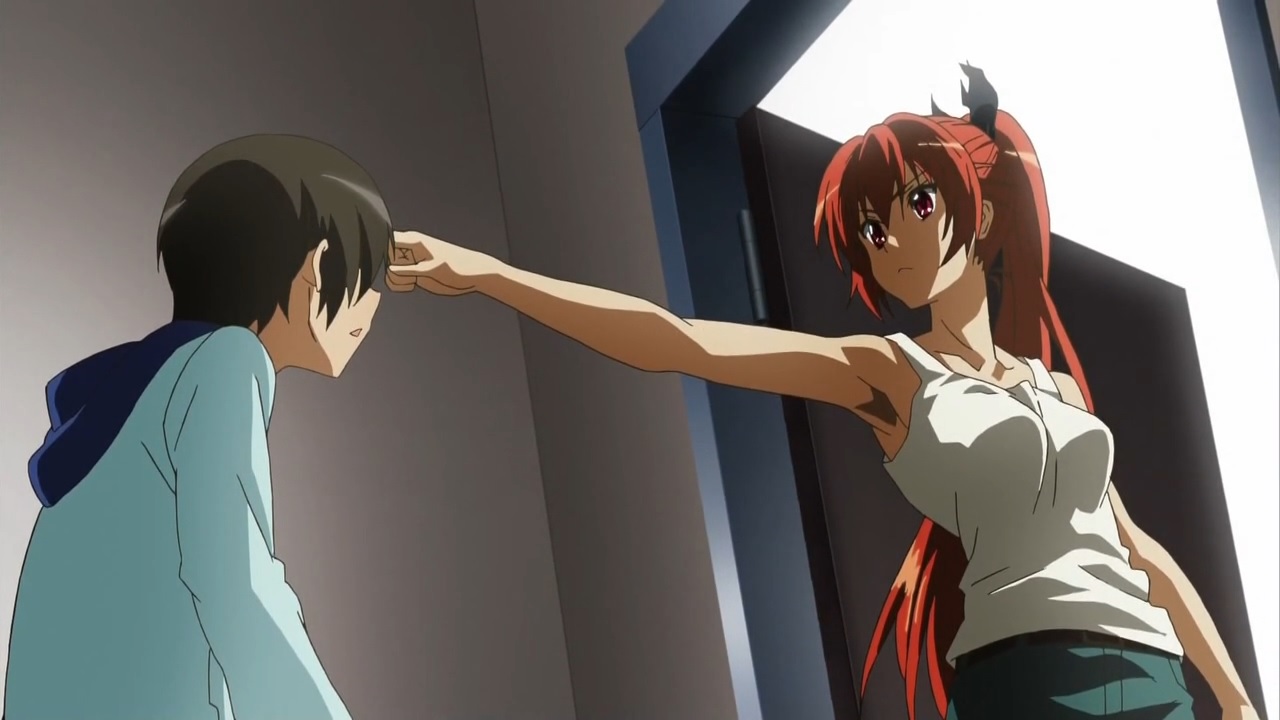
"You are already dead." (11:36)
The Japanese line is "Omae ha mou, shindeiru" (おまえはもう、死んでいる). This is referencing a line said by Kenshirou (ケンシロウ) in chapter 1 in volume 1 of "Hokuto no Ken" (北斗の拳), "Fist of the North Star", a manga series written by Buronson (武論尊) and published from 1983 to 1988. His line goes, "Omae ha mou shinderu" (おまえはもう死んでる), which has the same meaning as above. Image for reference:
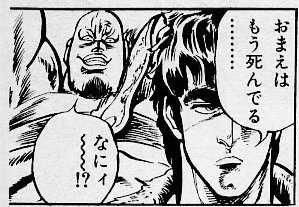
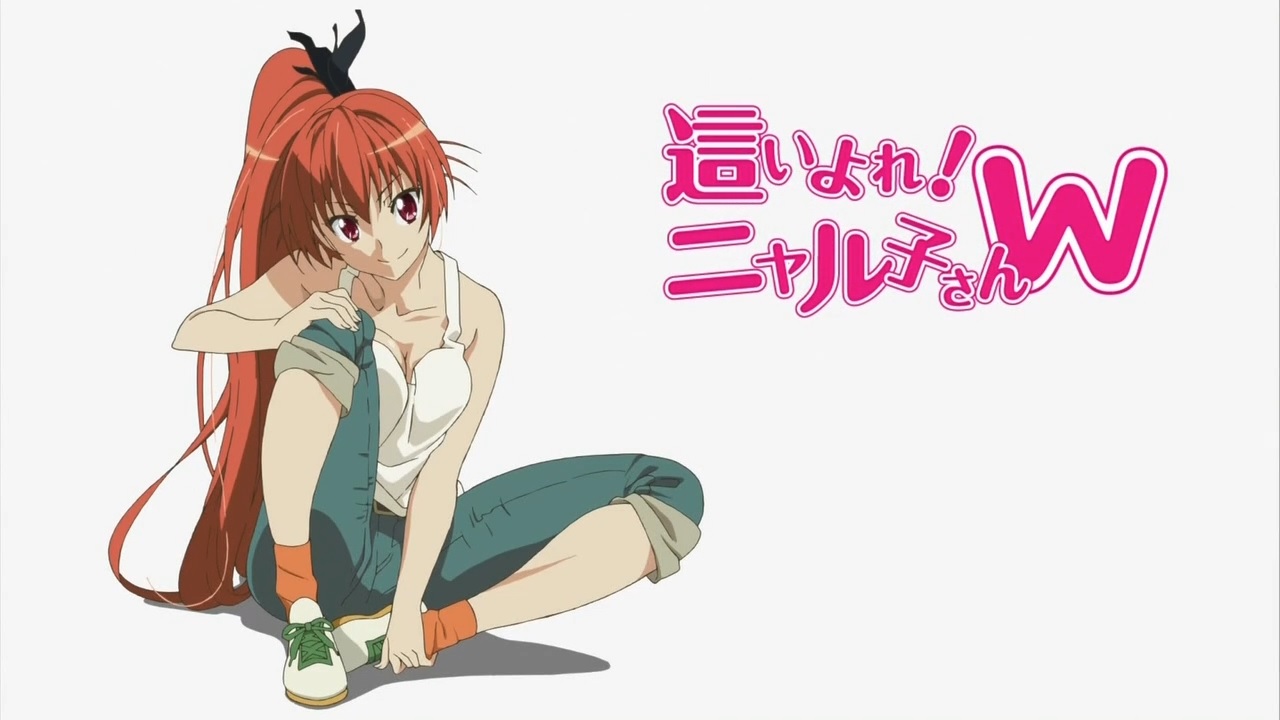
(11:43)
Cthune shouts, "Atatatatata!" (あたたたたた!). This is also referencing Kenshirou from "Hokuto no Ken" (北斗の拳), "Fist of the North Star". Kenshirou shouts in this manner when he attacks.S2 Image for reference:
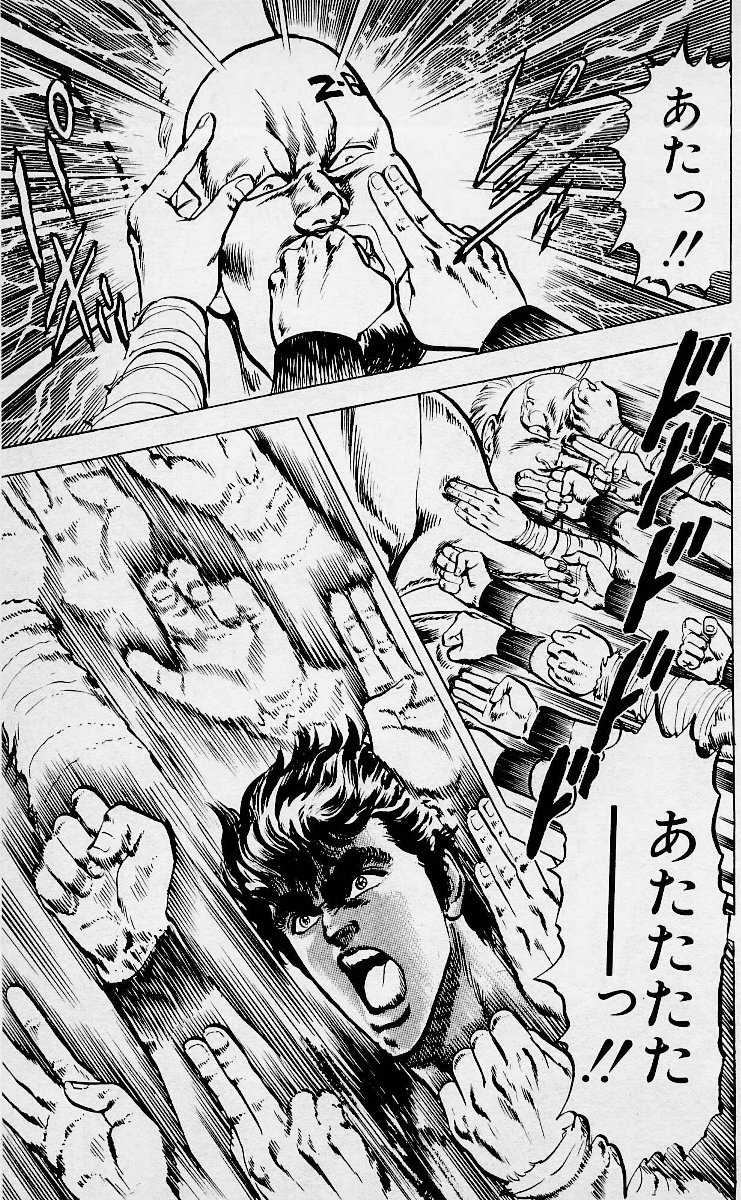
"Opuba!" (11:45)
Cthune says, "Opuba!" (おぷばっ!). This is likely referencing a character known as Neco-Arc (ネコアルク) that appears in "MELTY BLOOD" (メルティブラッド), a video game series that first began release in 2002. In the series, Neco-Arc can use a special attack named "Shinso Biimu" (真祖ビーム), "True Ancestor Beam". When using the EX Edge (EXエッジ) version of this attack, Neco-Arc will say, "Opuba!" (おぷばっ!). The likely connection is that Neco-Arc is voiced by Yuzuki Ryouka (柚木涼香), who also voices Cthune.S1 Video for reference:
https://youtu.be/tj2n8rSYwCQ?t=41
(11:49)
The Japanese line is "Hara horo hire hare" (ハラホロヒレハレ). This an onomatopoeia for the sound of something falling down in a fluttering or swaying manner. There are three references here:
* This line was famously used in a comedy act performed by Hana Hajime and the Crazy Cats (ハナ肇とクレージーキャッツ) on "Shabon Dama Horidee" (シャボン玉ホリデー), "Soap Bubble Holiday", a Japanese variety show that aired from 1961 to 1972 and from 1976 to 1977.
* This line is said by Harpy (ハーピー) in "Madou Monogatari" (魔導物語), "Sorcery Story", a video game released by Compile (コンパイル) in 1998. Image for reference:
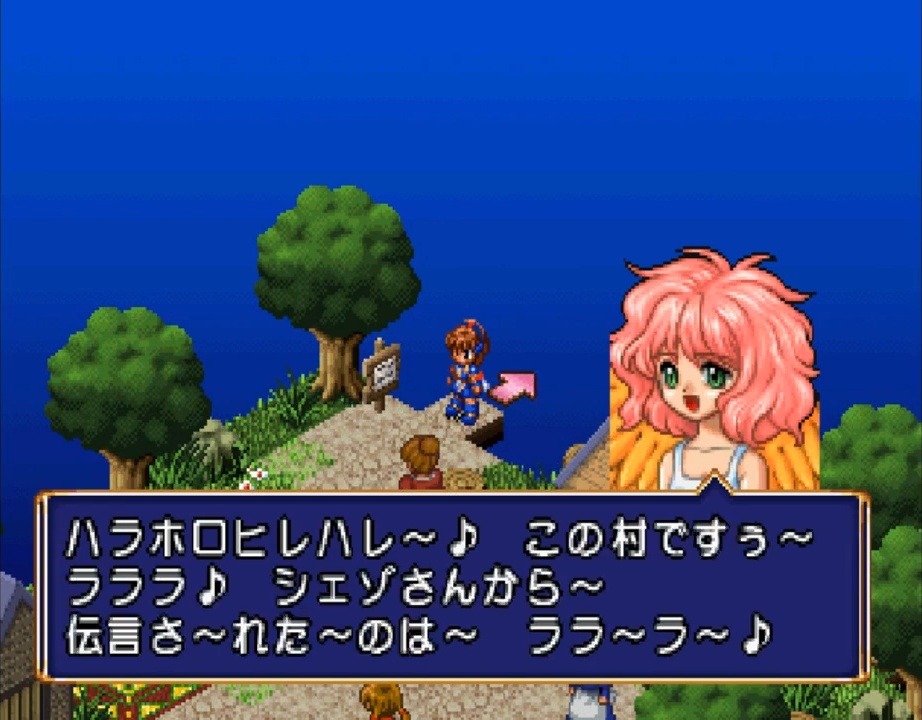
Source of image: https://www.youtube.com/watch?v=2YzYzL3KAcI
On a related note, the last boss of this game is called Yog-Sothoth (ヨグ・スォートス), which is the name of a creature that appears in the Cthulhu Mythos.
* This line is said by Harpy (ハーピー) in "Puyo Puyo~n" (ぷよぷよ〜ん), "Puyo Puyo 4", a video game released by Compile (コンパイル) in 1999. Here her line is written as 「はらほろひれはれ」 using hiragana instead of katakana. Image for reference:
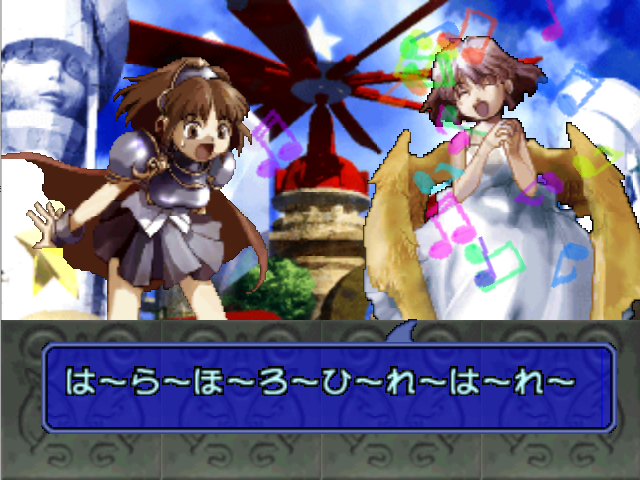
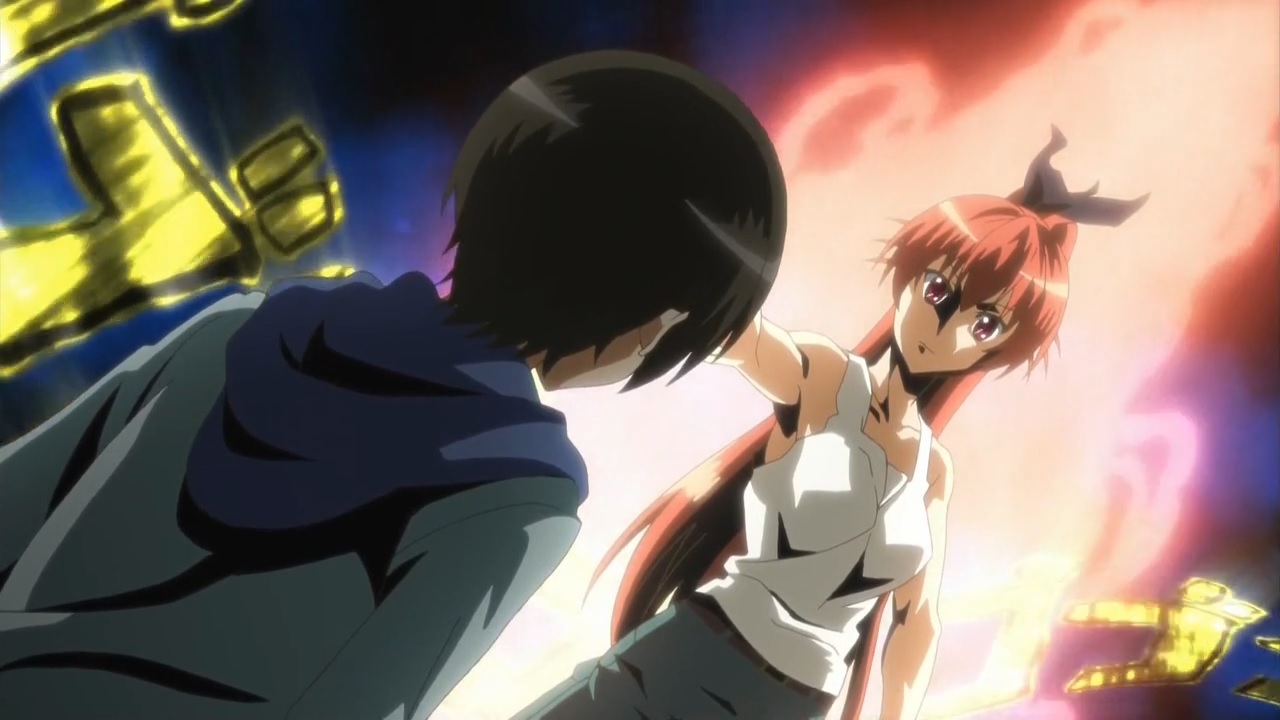
"Welcome to this crazy time." (11:53)
There are two references here:
* The line is referencing the same line in the lyrics to "TOUGH BOY", a song sung by TOM CAT and released in 1987.S1 This song is the opening theme song to "Seikimatsu Kyuuseiju Densetsu Hokuto no Ken 2" (世紀末救世主伝説 北斗の拳2), "Legend of the End of Century Savior: Fist of the North Star 2", an anime series that aired from 1987 to 1988.
* The Japanese character that repeatedly appears in the background is 「ゴ」 (go). This is referencing "Jojo no Kimyou na Bouken" (ジョジョの奇妙な冒険), "Jojo's Bizarre Adventure". In the series, 「ゴ」 (go) is used to represent dramatic tension. The series in general is known for showing a large amount of sound effects as onomatopoeia displayed as text. Here is an example of the text 「ゴ」 being used:
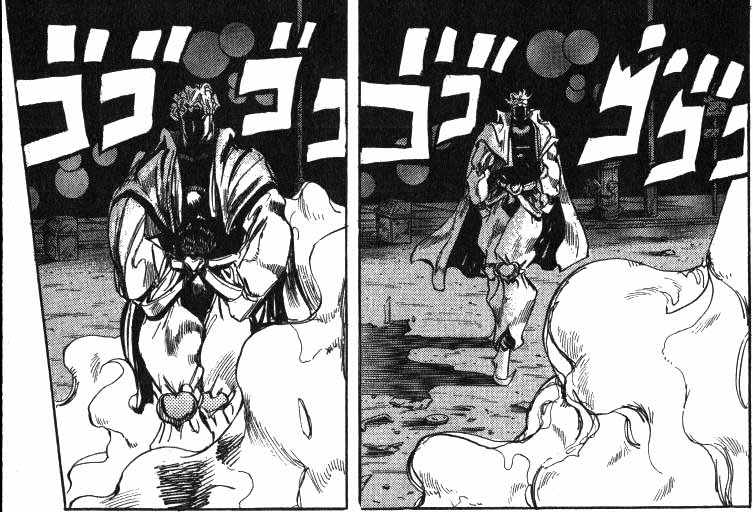
"I missed you! I missed you! I missed you! Yes!" (12:04)
The Japanese line is "Aitakatta! Aitakatta! Aitakatta yo! Yes!" (会いたかった!会いたかった!会いたかったよ!Yes!). This is referencing a line in the lyrics to "Aitakatta" (会いたかった), a song sung by AKB48 and released in 2006.S1 The line goes, "Aitakatta, Aitakatta, Aitakatta, Yes!" (会いたかった 会いたかった 会いたかった Yes!), which has the same meaning as above.
"Cute is justice!" (12:29)
The Japanese line is "Kawaii ha seigi da ne" (かわいいは正義だね). This is referencing the official tagline of "Ichigo Mashimaro" (苺ましまろ), "Strawberry Marshmallow", a manga series written by Barasui (ばらスィー) and published starting from 2001.S2 The original line is, "Kawaii ha, seigi!" (かわいいは、正義!), which has the same meaning as above. Images for reference:

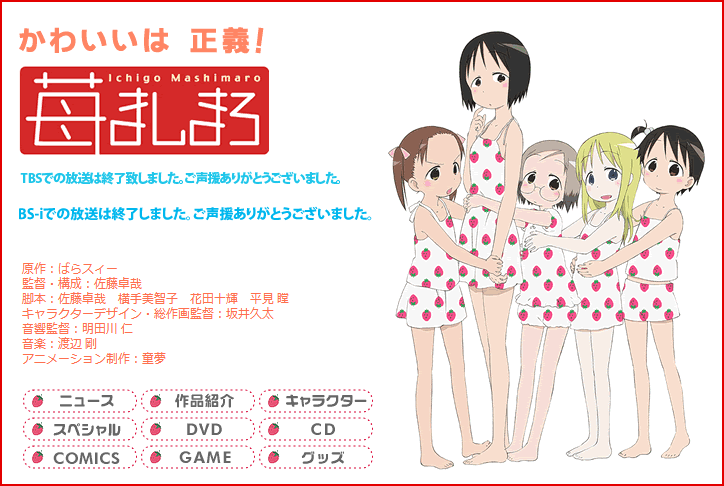
Image sources:
http://daioh.dengeki.com/contents/ichigo/
http://www.tbs.co.jp/ichigomashimaro/
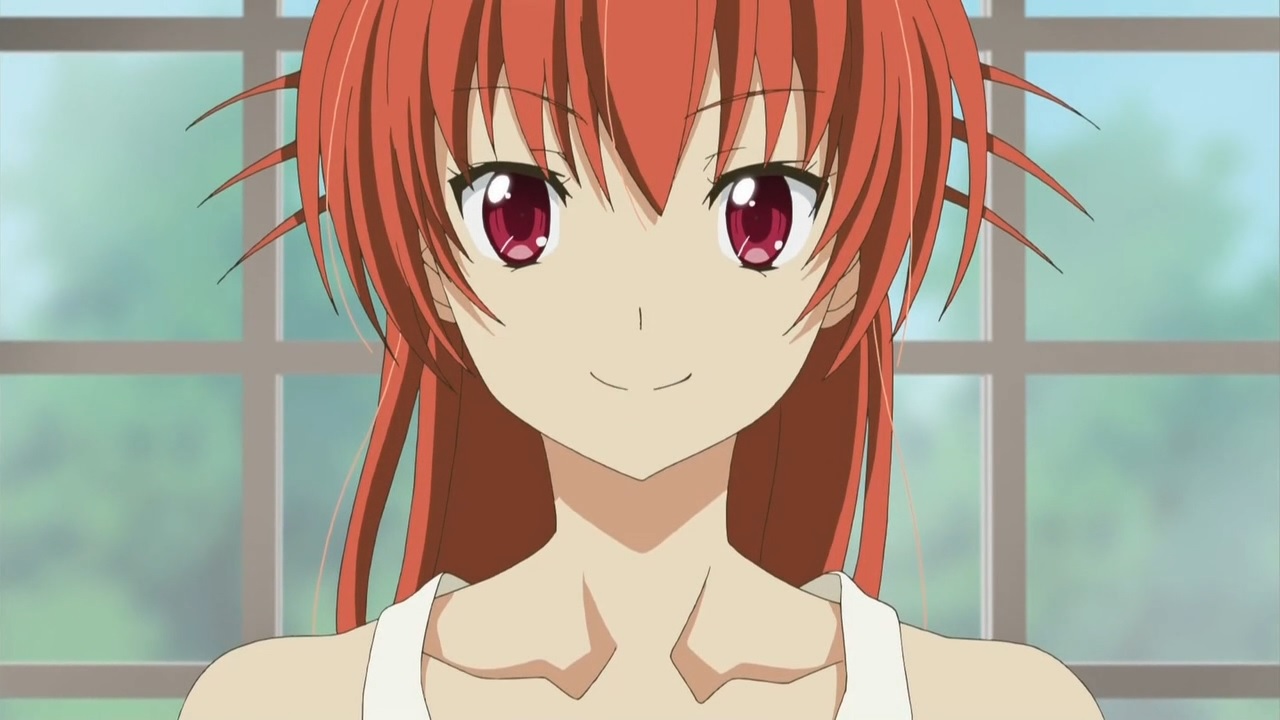
(12:51)
The character is Kuune (クー音), Cthune. Like her cousin, Cthuko, she is based on Cthugha, a creature classified as a Great Old One in the Cthulhu Mythos.
"I'm not great with Cthughaians." (13:07)
Nyaruko's line is referencing how Cthugha and Nyarlathotep have been established to be antagonistic towards one another in the Cthulhu Mythos. One example is in "The Dweller in Darkness", written by August Derleth and first published in 1944. In the story, the protagonists summon Cthugha to destroy the forest that Nyarlathotep is dwelling in.
(14:23)
The line at this time is "Pochi tto na" (ポチッとな). "Pochi" (ポチッ) is a Japanese onomatopoeic word expressing the sound of a button being pressed, and the line as a whole is expressing the speaker having pressed a button. This is referencing the same line said by Boyakkii (ボヤッキー) when he presses a button in Yatterman (ヤッターマン), an anime series that aired from 1977 to 1979.S2
"Test test, idiots and tests." (14:26)
The Japanese line is "Tesu tesu, baka tesu" (テス、テス、バカテス). This is referencing "Baka to Tesuto to Shoukanjuu" (バカとテストと召喚獣), "Idiots and Tests and Summoned Beasts", a light novel series written by Inoue Kenji (井上堅二) and published from 2007 and is currently ongoing.S1 One of the official abbreviations of the title of this series is "Bakatesu" (バカテス).
"Di molto! Di molto! Good!" (14:45)
The Japanese line is "Di mooruto! Di mooruto! Yoshi!" (ディ・モールト!ディ・モールト!良し!). This is referencing a catch phrase said by Melone (メローネ) in "Jojo no Kimyou na Bouken" (ジョジョの奇妙な冒険), "Jojo's Bizarre Adventure", a manga series written by Araki Hirohiko (荒木飛呂彦) and published starting from 1987. "Di mooruto" (ディ・モールト) is the Japanese pronunciation of "di molto", which means "very" in Italian. Melone uses the phrase to mean "hijou ni" (非常に), which means "very" or "extremely" in Japanese. In one such usage, his line goes, "Di mooruto di mooruto yoi zo!" (ディ・モールト ディ・モールト良いぞッ!), which translates to "Very very good!". Image for reference:
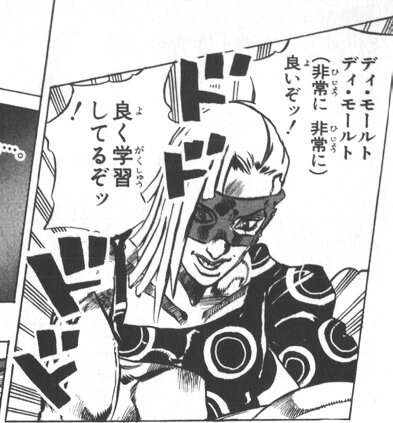
"I will throw away my reason! Cthuko!" (24:11)
The Japanese line is "Watashi ha risei wo suteru zo! Kuuko!" (私は理性を捨てるぞ!クー子!). This is referencing a line said by Dio Brando (ディオ・ブランドー) in chapter 11 in volume 2 of "Jojo no Kimyou na Bouken" (ジョジョの奇妙な冒険), "Jojo's Bizarre Adventure".S2 His line goes, "Ore ha ningen wo yameru zo! Jojo!!" (おれは人間をやめるぞ!ジョジョーッ!!), which translates to "I will abandon my humanity! Jojo!!". Image for reference:
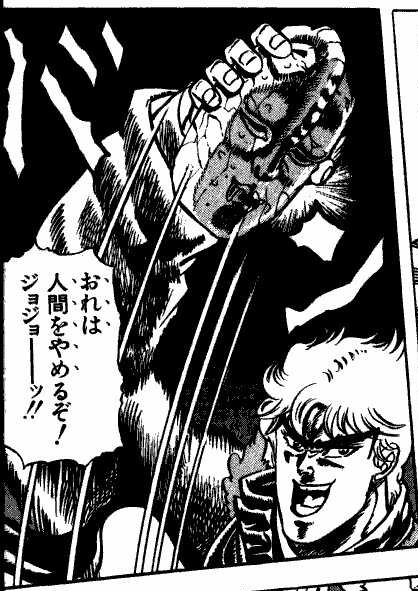
"Everyone, let's get Dagomon!" (24:21)
There are two references here:
* The Japanese line is "Minna mo Dagomon, getto da ze!" (みんなもダゴモン、ゲットだぜ!). This is referencing a line from the next episode preview of "Poketto Monsutaa" (ポケットモンスター), "Pokemon", an anime series that aired from 1997 and is currently ongoing. The line goes, "Minna mo Pokemon, getto da ze!" (みんなもポケモン、ゲットだぜ!), which translates to "Everyone, let's get Pokemon!".
* Dagomon (ダゴモン) is the name of a creature that appears in "Digimon Adventure 02" (デジモンアドベンチャー02), an anime series that aired from 2000 to 2001. On a related note, Dagomon itself is based on the Cthulhu Mythos. It first appears in episode 13 of "Digimon Adventure 02", and the title of this episode is "Dagomon no Yobigoe" (ダゴモンの呼び声), which translates to "The Call of Dagomon". This is referencing "Kuturufu no Yobigoe" (クトゥルフの呼び声), "The Call of Cthulhu", a short story written by H. P. Lovecraft and first published in 1928. Also, the appearance of Dagomon in the series is based on Cthulhu, and its name is based on Dagon, a sea dwelling creature and a servant of Cthulhu.
"Now, the adventure will evolve." (24:22)
The Japanese line is "Ima, bouken ga shinka suru" (今、冒険が進化する). This is referencing a line from the next episode preview for "Digimon Adventure" (デジモンアドベンチャー), an anime series that aired from 1999 to 2000.S1 The line goes, "Ima, bouken ga shinka suru" (今、冒険が進化する), which has the same meaning as above.
List of Sources:
S1. Comments on this post
S2. A post at Steman Blog (ステマブログ)
S3. A blog by servitors about Cthulhu Mythos inspired works (クトゥルー/クトゥルフ神話作品発掘記)
Thanks to everyone who contributed! This list wouldn't be nearly as long without you all. See you next episode!
情報を教えてくださって本当にありがとうございました!皆さんがいなかったら、このリストはぜんぜん長くありません。またこの次までね!
Last updated February 2, 2022
Sitemap
Home
